How to Plan a Perfect Sicily Road Trip Itinerary (7-14 Days)
Want to plan an amazing Sicily road trip where you get a taste of everything that makes Sicily special? Like the well-preserved ruins from Greek and Roman (sometimes even before that!) times, the amazing bounty of fresh produce from fruits and vegetables to pistachios, and the sheer amount of natural beauty from the slopes of Mount Etna to the beaches of western Sicily.
In this detailed Sicily itinerary, we’ll help you plan a trip that sees all of those things and more.
But first, why should you trust us?
We spent over three weeks on our own Sicily road trip, and loved every second of it. In fact, the majority of this guide was written while we were on the island, when the information and tips were completely fresh and details were still vivid in our minds.
Alysha’s grandparents were born in the small town of Melilli, near Siracusa, and emigrated to the United States from there just a few generations ago. She has wanted to visit Sicily for years, and we finally made it happen in 2021.
Of course, I totally recognize that you only really care about our experience if it helps inform your trip planning. So we’ve put together an itinerary that uses our own personal experience on a road trip around Sicily to help you plan an amazing trip.
In the guide below – which is very, very long – we’ll go through everything you need to know to plan your trip to Sicily. We’ll start with some very important basics – like how many days you need to see both eastern and western Sicily, and the best route to see the island in two weeks – and then we’ll go through a day-by-day, super detailed itinerary for two weeks in Sicily.
Don’t have two weeks to spend? We get it, vacation time is limited (at least for us Americans). Which is why we’ve included our take on ways to structure a 7 and 10 day road trip in Sicily ABOVE the actual itinerary, so you can still use the information in the itinerary to plan your own trip even if it’s not a full two weeks.
Sound good? Off we go to Sicily!
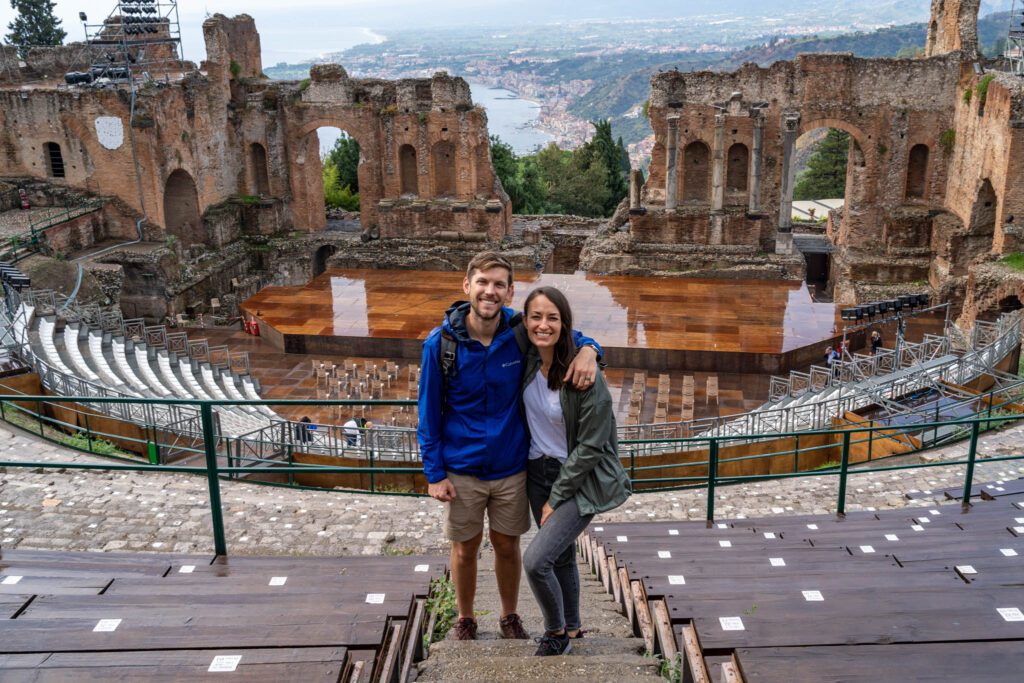
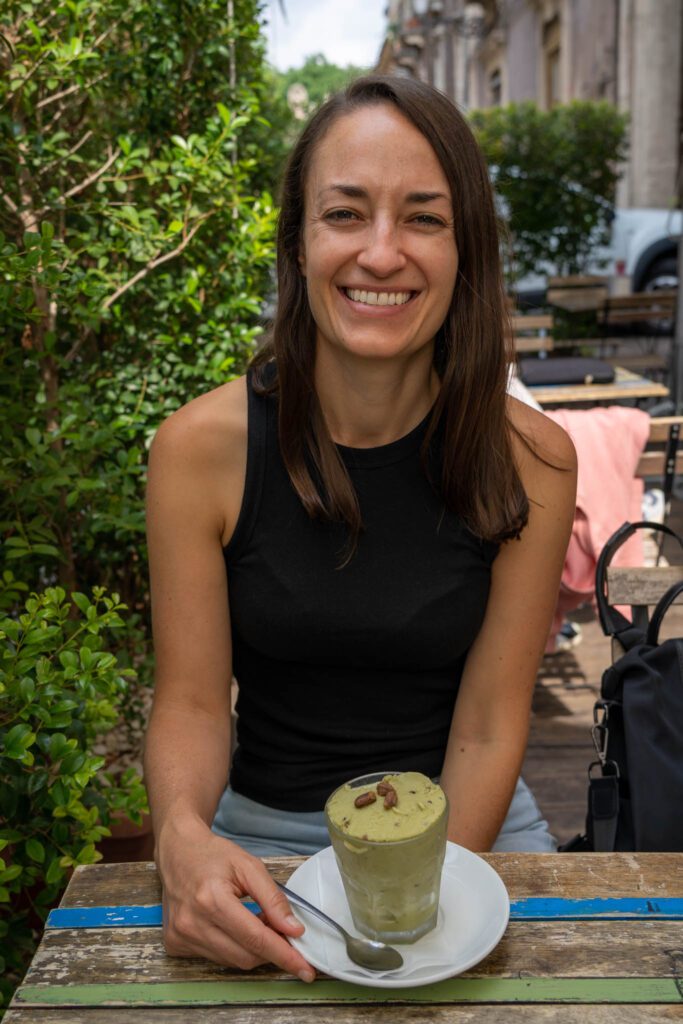

Disclaimer: Some of the links in this post, like hotel links, are affiliate links, meaning at no additional cost to you, we make a little bit of money if you click through and book. That being said, we would never recommend something to you that we don’t stand behind 100%.
How Many Days Do You Need in Sicily?
At a high level, we think you’re going to need at least two weeks (14 days) to see both eastern and western Sicily. Anything less than that and you’d need to cut some of the best sights in each region to try and fit it all in, which we would absolutely not recommend.
Even two weeks is going to mean you’re just seeing the highlights. We’ve done our best to pick and choose between places you could go based on our own personal experiences exploring the island, but even with three weeks we made some tough decisions on things to skip.
Any 7 or 10 day itinerary that has you spending one night in each place is unpractical (impractical doesn’t fit with the “un” thing I’ve got going on here – forgive me), unrealistic, and unpleasant.
Believe me, we’ve done things that way on previous trips, and choosing to spend more time in fewer places is almost always a good decision.
With that in mind, if you have less than two weeks in Sicily, focus your time on either eastern or western Sicily, take your time, and explore a little deeper.
The complete itinerary we’ve put together below is for 14 days, but we’ve also got a section outlining what to do with less time above that to help you figure out how to spend your time with 7-10 days.
The good news is that, once you’ve decided on a route, you can read through the relevant sections of the detailed itinerary (and let’s be clear, we do mean DETAILED) to give you an idea of what to do and see, where to stay, how to get places, and more.

Where to Start and End Your Trip
The short answer is “it depends.” And it depends on two main factors.
The first thing it depends on is your mode of transportation to get to Sicily. There are two main hubs in terms of flying to Sicily – Catania and Palermo.
Messina, the northeastern tip of the island, is where you’ll arrive if you’re driving or taking the train from the mainland (both involve a ferry).
The second thing it depends on is how much time you have.
Like we mentioned above (and you’ll hear us say it over and over again below, because we think it’s that important), you really can’t see the entire island in 7-10 days. Or even 14 days, really, but we think that’s the minimum amount of time you need to hit both eastern and western Sicily in your itinerary.
If you have 7-10 days, you’ll want to focus on one side of the island or the other, which means you can fly in and out of the same airport (either Catania or Palermo).
If you have 14 days, it works best if you fly into one (or ferry to Messina) and fly out of the other, which will save you three to four hours of driving, but will cost a little extra in terms of rental car, which will likely incur a one-way fee.
This is how we have the detailed itinerary below structured, just know that if you want to fly in and out of the same airport at the beginning and end of your trip, it’s going to add some driving and it’s going to be less convenient.
We think the cost is worth the added convenience and time saved, but you might feel differently, so we want to give you the option!
Getting Around Sicily
There’s really only one thing you need to know about getting around Sicily: you need a car once you’re outside of the major cities, which are basically Palermo and Catania (and we’d add Syracuse just because it’s so compact and walkable).
Do You Need to Rent a Car in Sicily?
In short, most likely. Renting a car is the only way you’re going to be able to get to some of the beaches and sites that are outside of city centers. Once you get outside the center of most cities in Sicily, public transportation is spotty at best, and nonexistent at worst.
Can you cobble together an itinerary that uses only public transportation? Yes. Will you be missing out on some of the more far flung destinations in Sicily that ended up being among our favorite places? Also yes.
Renting a car will give you the most flexibility and autonomy to explore at your own pace. HOWEVER. We recommend avoiding having a rental car in big cities like Palermo, Catania, and even Syracuse, where you won’t need it if you follow the itinerary below, and it’s more of a hassle than a benefit.
For that reason, we’d recommend picking up your car AFTER you visit Catania and Syracuse, and returning it BEFORE arriving in Palermo. It’ll also save you money on parking and gas, bonus!
One thing to know is that if you can’t drive a manual (stick shift) car, you’re going to pay a hefty premium for an automatic transmission. We know that, because we can’t drive a manual. Most cars in Sicily are manual transmission, and this is not the place to learn how to drive a stick.
We rented through AutoEurope and had a lovely experience from picking up the keys in Siracusa to dropping them off at the airport in Palermo. We’d highly recommend getting some level of insurance, because stuff happens in Sicily. Particularly car stuff, with tiny narrow alleys and reckless driving all over the place. Click here to check prices and availability for a rental car through Auto Europe.
Driving in Sicily

You’ve probably heard that driving in Sicily is a nightmare. And, in some ways, that’s true. It’s not for nervous drivers, or for people who aren’t comfortable driving in the best of scenarios.
Here are a few tips we’ve gleaned from our Sicily road trip to help you navigate the (sometimes wild) streets of Sicily.
First, forget the rules you thought you knew – right of way and yielding, following speed limit signs, and the like – driving in Sicily is much more of an organic experience. People go with the flow, consider any signage as a mere suggestion rather than a rule, and it somehow all works out at the end of the day.
Even our guide for our trip to Mount Etna, who grew up in Catania, said he hates driving in the city. As we sat at a stoplight in the heart of Catania, we watched not one but two separate cars pull up next to us, look around, and drive right through the red light.
See? Said our guide. A suggestion.
Driving in Sicily was not as bad as I thought it was going to be, but it was vastly different from driving at home and in other countries we’ve driven in. Here are a few things to keep in mind.
- ZTLs: Many cities have a zone in the center where you cannot drive without a local residential permit. These areas are marked with signs that say “Zona Traffico Limitato” with hours and dates posted. Sometimes, your accommodations will be in that zone, which means you should not drive to the hotel. Park outside the ZTL (more on parking in the next bullet) and walk in, or message your hotel in advance and ask them what the best way to reach them with a car would be.
- Parking: Always have an idea of where you want to park before you arrive somewhere. Search “parcheggio” on Google maps to find parking lots (usually paid, though some are free). Or wing it and try to find street parking. No marking or white curb? It’s free (though look out for limited times – e.g. 30 minute parking). Blue lines or curb? You pay at a pay station, which can usually be found nearby and often only take coins.
- Roundabouts: Listen, I’m 100% on board with roundabouts after a Freakonomics episode on how they save lives and money. But the way Italians handle them, I’m not sure they can possibly save lives. Yield to traffic in both directions, because there’s no guarantee they will return the courtesy. This is really only a problem in cities.
- Speed Limits: Signage is actually pretty good – look for signs with a white circle with a red outline and a number in the middle. However, almost nobody follows them. There were countless times on one of the main highways where I’d be dutifully going the speed limit, and I’d be passed by literally every car that came by. And those no passing signs (or double white lines)? Don’t expect anyone to follow them. Two lane roads often become three and four lanes with people passing going in both directions.
Public Transportation in Sicily
Public transportation is an okay option for visiting very specific parts of the island. It can be very useful for getting between cities on the east coast, for example. But where public transportation falls flat is getting outside major cities.
As an example, we really enjoyed getting outside of Noto to the Vendicari Reserve and Marzamemi, and it was one of our favorite afternoons in Sicily. You would have a very, very hard time doing that without a car. In fact, it would be nearly impossible.
If you’re okay with sticking to the main cities and tourist attractions – for example, on the east coast Taormina, Catania, and Siracusa – then public transportation will work. If you’re interested in doing some exploring and getting one foot off the beaten path, you’re going to need a car.
Trains – through Trenitalia – are an option on the east coast (and eastern Sicily in general) in the corridor between Messina and Siracusa, but buses through Interbus are often a faster, cheaper, and overall better option for getting between places in Sicily due to the number of transfers you’ll need to make on trains.
Planning Your Sicily Itinerary: Route Options
It bears repeating in case you missed it above: Sicily is massive. It’s the largest island in the Mediterranean at just under 10,000 square miles, which means there’s just no possible way you’re going to see everything there is to see in 7, 10, or 14 days.
It’s about picking and choosing, and we’re here to help you make some decisions on what to pick and choose based on our own personal experience road tripping around Sicily.
With only 7 or 10 days, we think you should choose between eastern and western Sicily and focus your time on just one, rather than trying to zip around and see the entire island in a short period.
By the way, we have an entire separate guide dedicated to helping you make the most of 7 days in Sicily, if you only have a week on the island.
With 14 days or more, we think you can see the entire island, but it will still feel a bit rushed. For context, we had three weeks, and there are still places we missed entirely and are already thinking about planning the return trip.
The detailed itinerary below gives you a complete 14 day Sicily road trip itinerary, which includes stops along the east, south, and western parts of the island. If you have two weeks in Sicily, that would be a good place to start.
But what if you have less time?
Here are some itinerary options for those of you who have 7 or 10 days. We’re giving you options for the eastern and western parts of Sicily too!
You can then take your shorter itinerary and use the information below in the detailed itinerary to plan out what to do and see and where to stay in each place.
7 Days in Sicily
If you have a week, you should head straight to our guide to spending 7 days in Sicily, where we go into detail on how to spend 7 days on either the eastern half of the island OR the western half of the island.
Again, we really, really discourage you from trying to see it all in just seven days.
You’ll end up rushing through everything and it won’t be nearly as satisfying as taking it a little slower and having the time to stop at that random cafe you stumble upon for an afternoon granita, or an aperol spritz on the coast.
Eastern Sicily in 7 Days
If you want to focus on eastern Sicily, which includes gems like Mount Etna, Taormina, and Syracuse (among other things), here’s our best thinking on how to spend your time.
- Day 1: Arrive in Catania & Explore
- Day 2: Pick up Car and Taormina
- Day 3: Day Trip to Mount Etna (Stay in Taormina)
- Day 4: Syracuse & Ortigia
- Day 5: Syracuse & Ortigia
- Day 6: Val di Noto (Beaches & Marzamemi)
- Day 7: Val di Noto & Fly Home from Catania
Western Sicily in 7 Days
In Western Sicily, here’s an idea of how to spend your time.
- Day 1: Arrive in Palermo & Explore
- Day 2: Palermo
- Day 3: Day Trip to Cefalu (Sleep in Palermo)
- Day 4: Pick up Rental Car, Riserva Naturale Orientata dello Zingaro, San Vito Lo Capo
- Day 5: Segesta & Drive to Trapani
- Day 6: Day Trip to Erice from Trapani
- Day 7: Fly Home from Palermo
10 Days in Sicily
If you have 10 days, you’ll be able to add a few other destinations in either region, but we really think you should still focus on either western or eastern Sicily, not both.
Eastern Sicily in 10 Days
With 10 days, add on Agrigento, home of the Valley of the Temples, and a stop in Modica or Ragusa along the way.
One other thing to note: you can fly out of either Palermo or Catania here since they’re roughly equidistant. It’s worth checking prices, but it’ll probably be cheaper to fly in and out of the same airport if we had to guess.
- Day 1: Arrive in Catania & Explore
- Day 2: Pick up Car Early & Drive to Taormina
- Day 3: Day Trip to Mount Etna (Stay in Taormina)
- Day 4: Syracuse & Ortigia
- Day 5: Syracuse & Ortigia
- Day 6: Val di Noto
- Day 7: Val di Noto
- Day 8: Agrigento (Stop in Modica & Ragusa along the way)
- Day 9: Agrigento (Valley of the Temples)
- Day 10: Fly Home from either Palermo or Catania (Equidistant)
Western Sicily
With 10 days in Western Sicily, add on a few extra days out on the coast, using Trapani as your home base.
- Day 1: Arrive in Palermo & Explore
- Day 2: Palermo
- Day 3: Day Trip to Cefalu
- Day 4: Pick Up Car & Drive to Castellammare del Golfo
- Day 5: Riserva Naturale Orientata dello Zingaro (Stay in Castellammare del Golfo)
- Day 6: Segesta & San Vito Lo Capo
- Day 7: Trapani (Day trip to Erice)
- Day 8: Selinunte & Drive to Agrigento
- Day 9: Agrigento (Valley of the Temples)
- Day 10: Fly Home from Palermo
Two Weeks in Sicily
Finally! 14 days in Sicily means you can squeeze in the main sights in both halves of Sicily (though you’ll still be making some decisions in terms of what to see and what to save for a future trip).
This version of the Sicily itinerary works best if you fly into either Catania or Palermo, and fly out of the other city.
In other words, it’s best done as a one way itinerary, which means you might be paying a premium for an open jaw flight (a flight that flies into one city and out of another) and a rental car, which often include a one-way fee.
For what it’s worth, we did it as a one way trip, and feel the extra cost is worth the convenience.
However, if you don’t agree with that assessment, it’s easy enough to do it in and out of a single airport. You’ll just have to budget some extra time (three to four hours with traffic) of driving back from one end of the island to the other.
You can do this road trip in either direction. We did it east to west, which is why it’s oriented that way here, but you can pretty easily flip it.
Another note: You aren’t going to want to have a car in either Palermo, Catania, or Syracuse. Pick up the car when you’re ready to leave either city, and drop it off before you head into the city to explore. You won’t need a car once you’re in the city.
Here’s the itinerary for two weeks in Sicily, which you’ll find in much greater detail below.
- Day 1: Arrive in Catania & Explore
- Day 2: Day Trip to Taormina (Stay in Catania)
- Day 3: Day Trip to Mount Etna (Stay in Catania)
- Day 4: Syracuse & Ortigia
- Day 5: Syracuse & Ortigia
- Day 6: Pick up Rental Car & Drive to Noto
- Day 7: Val di Noto (Beaches & Marzamemi)
- Day 8: Drive to Agrigento (Stop in Modica along the way)
- Day 9: Agrigento (Valley of the Temples)
Day 10: Selinunte, Segesta, and Drive to Castellammare del Golfo - Day 11: Day Trip to Riserva Naturale Orientata dello Zingaro (Sleep in Castellammare del Golfo)
- Day 12: Drop off Rental Car at Palermo Airport & Palermo
- Day 13: Palermo
- Day 14: Fly Home from Palermo
There are two main things missing from this itinerary that would be the first additions we’d make with extra time. The first is a day trip to Cefalu from Palermo, which is a lovely beach town along the northern coast of Sicily. The second is a stop in Trapani to visit the hilltop town of Erice, which has some great views, but wasn’t exactly our favorite place in the world (which is why it got relegated to the “more time” section after we did it).
In the “More Time?” section below the detailed itinerary, you’ll find our thoughts on what to do and see in both of those places.
A Complete Guide to Planning a Two Week Sicily Road Trip
Now that we’ve got all the important information you need to know to plan your trip to Sicily, onto the complete guide to planning your Sicily itinerary!
Please note that in this itinerary, you do not need a rental car for the first five days. Our recommendation – and this is exactly what we did – is to pick up your rental car in Syracuse, before driving to Noto. This way, you avoid driving and parking in two of the more stressful cities on this itinerary (Catania and Syracuse).
Then, plan on dropping your rental car off in Palermo (at the airport) as you arrive – you do not need a rental car in Palermo either, and it’s equally chaotic and stressful to drive there (if not more so).
This also has the added benefit of saving you a little bit of money, since you are cutting four to five days of rental car costs (gas, parking, tolls, etc).
There is one implication here, which we will touch on in the Mount Etna section below, and that implication is that you will not be able to reach the summit of Etna because of the way the timing, tours, and public transit connections work out.
If getting to the summit of Etna is a must-do for you, then you will need to rent a car so that you can arrive in Refugio de Sapienza before 9:00 am, which is when the summit tours depart.
Note that I do mean the summit, which is only accessible by guided tour and in good conditions. You can still get up to the Torre del Filosofo and the Laghetto Crater via public transit or a guided tour from Catania.
That’s probably good enough for most people, including us, but it’s worth calling out as an implication of the way we’ve structured this Sicily road trip itinerary.
With that out of the way, off you go to explore Sicily!
Day 1: Exploring Catania
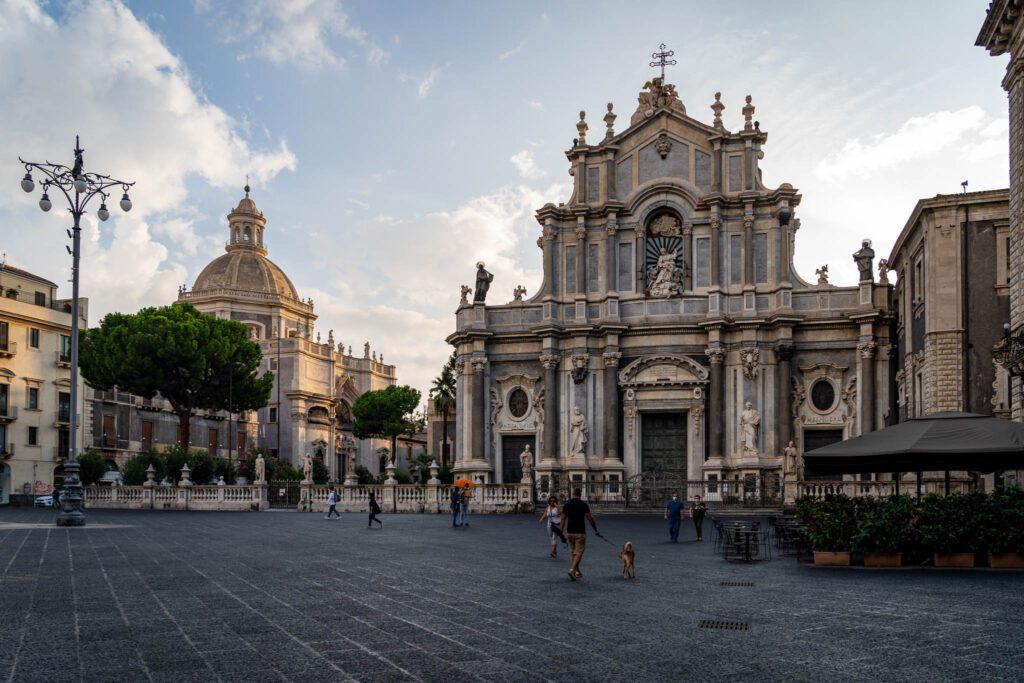
On your first day, you’ll be arriving in Catania, the second biggest city in Sicily and, in many ways, the forgotten city in Sicily.
I say the forgotten city because a lot of people – I’d venture to guess the majority – skip Catania altogether in favor of places like Taormina and Syracuse, which we think would be a mistake for two reasons.
First, there’s no better place for exploring Catania, Mount Etna, and Taormina than, well, Catania. It has the best connections for getting to all those places. Your other option is Taormina, which isn’t as well-connected AND is more expensive (though it is pretty damn charming).
Second, Catania is worth a day in its own right! There are a couple of very cool things to do, see, and eat in Catania, and it’s a good introduction to Eastern Sicily and Etna’s history.
Catania has been around for millennia – there is evidence of humans going back to the Neolithic Era – and has been home to Greeks, Romans, and multiple other groups and combinations of people over that time. It’s literally a city built on top of a city built on top of another city, as you’ll learn over the course of your time there.
In the 17th Century CE, Catania was affected by two natural disasters in a span of 24 years. First, in 1669, was the eruption of Mount Etna, which didn’t have any major effects on the city in terms of destruction, but did permanently alter the north and western sides of the city, and pushed the coastline out two kilometers further into the sea (which is NUTS). Then came the big one.
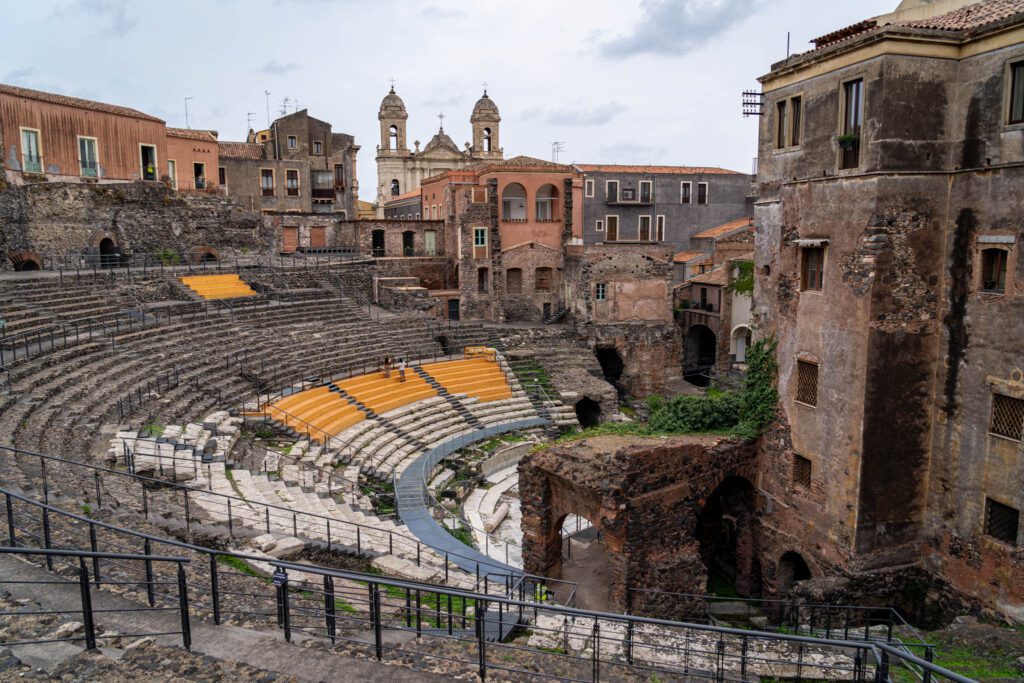
In 1693, a 7.4 magnitude earthquake leveled most of Catania, and the city had to be largely rebuilt, along with most of the rest of Eastern Sicily. And from those ashes, Sicilian Baroque architecture was born.
Like we said, lots of history here, and well worth a day of your time to understand the context around the places you’re going to be seeing on the first half of this road trip, roughly.
Things to Do in Catania
Here is a collection of things we enjoyed in Catania, in no particular order. Note that you won’t find any of the many day trips we did from Catania here, because you’re doing Taormina and Mount Etna over the course of the next two days.

- Guided Tour of the Benedictine Monastery: Part history lesson, part beautiful building, this was our favorite experience in Catania. It was one of the biggest monasteries in Europe, and the hour-long guided tour takes you down underground to learn about the history of the building and the city as a whole, as it happens to be a great example of how the city adapted to the lava flows from the 1669 eruption. At the time of writing, you had to reserve your spot in advance, which you can learn more about here.
- Granita: Granita is a delicacy in Sicily, and you’ll find it at just about every cafe and pasticceria on the island. But what is it? It’s basically ice cream without the cream. It’s a combination of ice, sugar, and seasonal local ingredients like pistacchio, almond, fruits like lemons and strawberries, and even coffee. It’s delicious. Our favorite in Catania was at Caffetteria Villaroel (here on Google Maps) – get the pistacchio if they have it!
- Teatro Romano di Catania: The first of many Roman theaters you will see on this itinerary, this is a great example of how the city is literally built on top of an old city. You’ll see the modern buildings of Catania as we know it today towering over an excavated Roman theater that was built in the 300s BCE. It’s worth an hour of your time, and there is some okay signage (with some iffy Google Translate English translations) to help you understand what you’re looking at. Book tickets in advance here (required when we were there), or buy when you get there.
- Eating in Catania: The food in Sicily is outstanding, and Catania is a great introduction. The fertile volcanic soil of Etna is known for producing great produce, wine, and nuts. First of all, we’d be negligent if we didn’t mention the raucous and energetic fish market, which our apartment happened to be right on top of. It’s not just fish – there’s local vendors selling meat, cheese, fruits and vegetables, and nuts – all coming from nearby. It takes place every day except Sunday just south of Piazza del Duomo. You should make an effort to try pasta alla norma in Catania, which is a combination of pasta, tomatoes, eggplant, and salty ricotta salata (which is delicious, we might add).
For more of our favorite things to do in Catania, make sure to read our more detailed guide here.

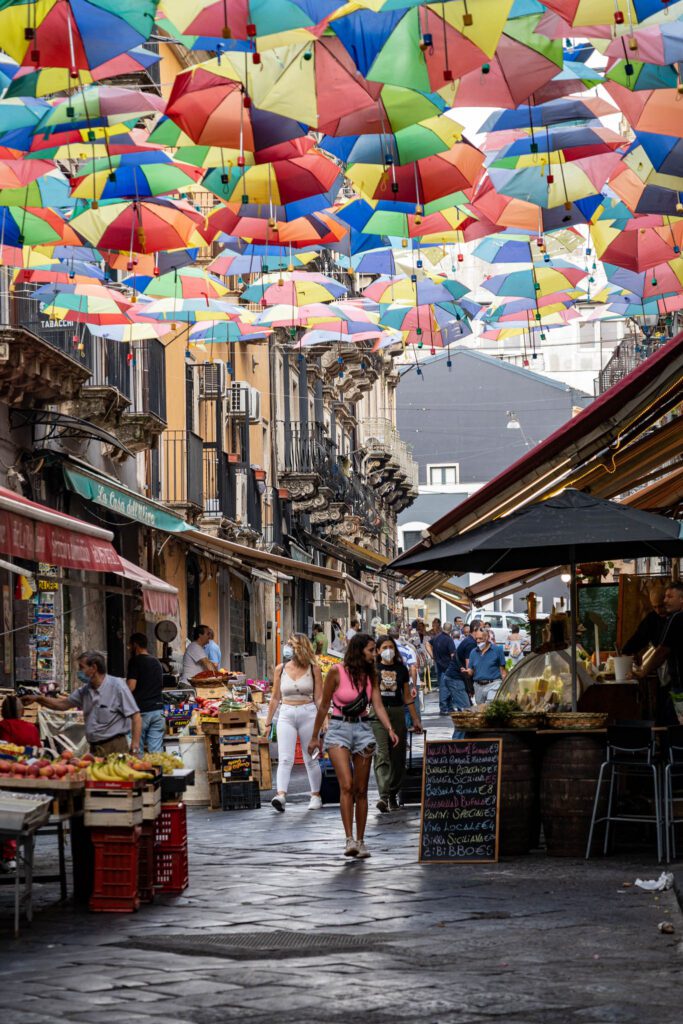
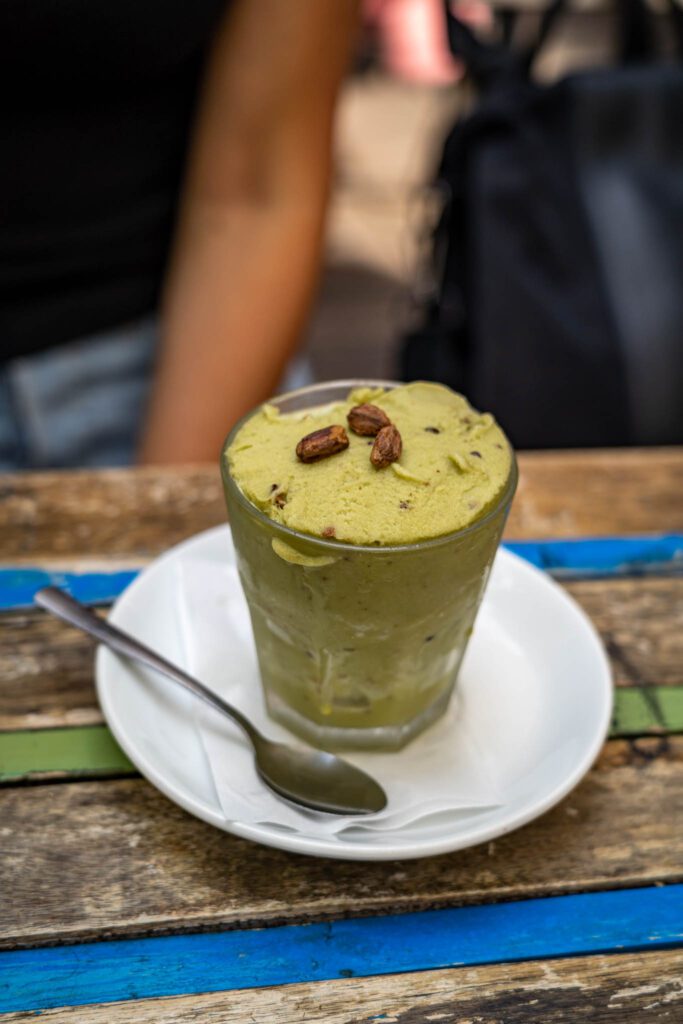
Where to Stay in Catania
You’ll be using Catania as a home base for the first three days of this itinerary, so keep that in mind when you’re choosing a place to stay.
At a high level, the best place to stay in Catania is between Piazza del Duomo and Villa Bellini.
I’d avoid going more than two or three blocks east or west of Via Etnea, if you can. We stayed right off of Piazza del Duomo – right over the fish market – and it was a phenomenal location in terms of centrality and walkability.
Well worth the slightly fishy aroma drifting up from the street below in the afternoons, when we were hanging out with the windows open.
We stayed at Duomo Housing Catania – the deluxe apartment, specifically – which was gigantic compared to some other places we’ve stayed in Italy.
Seriously, it’s almost as big as our old apartment in San Francisco. We should note that if we were to do it again, we’d choose the apartment with a terrace which is smaller, but has a nice view of the Duomo.
If you’re on a budget, we had originally booked the Yard Hostel in Catania, but at the time we were traveling we weren’t quite sure about being in a place with so many shared facilities, so we ultimately cancelled.
We were really excited about it, even though it’s a few blocks north of Villa Bellini. They have dorms and private rooms, and it gets consistently stellar reviews.
Here are some other options in the area that we’ve picked out for you.
- Le Suites Del Duomo House – another option for apartments on Piazza del Duomo.
- Ferrini Home – Etnea Collection – excellent apartments at the northern end of Via Etnea.
- Habitat – a stunning and stylish boutique hotel a few blocks west of Via Etnea.
Day 2: Day Trip to Taormina (Stay in Catania)

On your second day, take a day trip up the coast to Taormina, a lovely little seaside town up on a hill with great views and a spectacular ancient theater that’s well worth the trip.
Remember, you’re staying back in Catania on this night (if you’re following our advice of picking up your car at the end of your time in Syracuse).
Getting to Taormina
Without a car, you have two options for getting to Taormina from Catania. You can either take the train from Catania Centrale (Catania’s main train station), which is about 15-20 minutes from Piazza del Duomo on foot, or you can take a bus through Interbus.
The train is faster at 35-60 minutes or so (depending on whether you choose the faster Intercity train or the slower and cheaper regional trains) but drops you off at the bottom of the hill under Taormina.
You can either walk up the hill (that’s what we did) in 20 minutes or so, or take the bus (Interbus, again) that goes up the hill from the train station and costs 1.90 Euros.
Book through Trenitalia from Catania Centrale to Taormina-Giardini (the train station at the bottom of the hill).
Here’s the route that you’ll follow to walk from the train station to the center of town.
The bus – through Interbus – takes longer, but drops you off much, much closer to town, and is the way that our Mount Etna guide recommended. We took the train and walked from the train station up the hill, which wasn’t bad at all even though there was a torrential downpour when we were there.
The bus is a bit slower – taking about 75 minutes to complete the journey – but it’s direct and cheaper at 5.50 Euros each way.
You have to pick up the bus from close to Catania Centrale – here is the location on Google Maps.
Overall, both are good options, though the bus being more frequent, direct, and cheaper makes it a more attractive option for most people.
Things to Do in Taormina
Here is a collection of things we enjoyed in Taormina, in no particular order. You can essentially spend as much or as little time in Taormina as you’d like, but be aware of train and bus schedules so that you know when you need to be heading back (and don’t get stuck waiting for an hour).
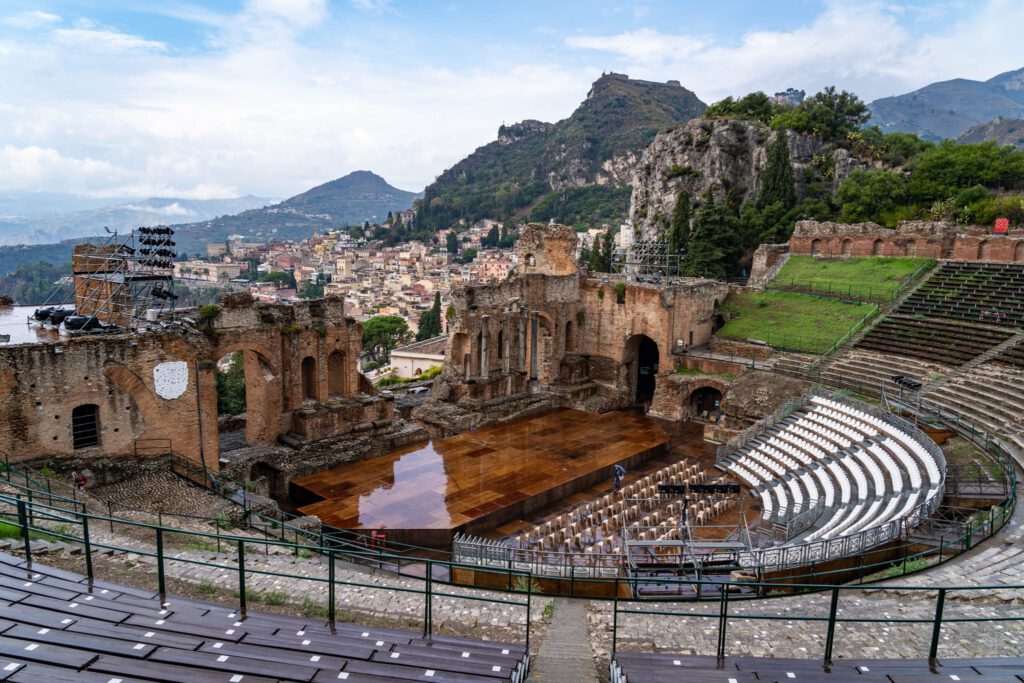
- The Greek Theater: The first stop you should make is the spectacular Teatro Antico di Taormina, which sits at the top of a hill with amazing sea views from the seating area. They hold concerts and shows here, and I’d definitely recommend seeing if there’s anything going on around the time when you’re in town and shaping which day you do Taormina around that. More information here.
- Granite at Bam Bar: After all that walking, you deserve a treat. And Bam Bar should be your treat of choice. Come for the granita, which is so good that we actually went twice in the span of a couple of hours, stay for the pastries and aperitivo as evening approaches. They’re known for granita, and the rotating flavors are posted on the board under the canopy. Get a seat outside for some good people watching.
- Wander along Corso Umberto: Corso Umberto is the main, pedestrian-only street running through the heart of Taormina, and is full of shops, bars, and restaurants. It’s absolutely packed with tourists, but it’s worth a stroll. Stop to admire the views and the church at Piazza IX Aprile, you might even be lucky enough to catch a wedding, like we did!
- Hike up to Chiesa Madonna della Rocca: For an exquisite view over Taormina and the water beyond, make the steep climb up to this church on a hill (find it here on Google Maps). The views are stunning. You can continue up to Castello di Mola allll the way at the top of the hill for even better views, but it’s quite the climb. Consider taking a taxi up, then walking back down. There are some good restaurants up there for lunch, too.
- Hit the Beach! Isola Bella is at the base of the hill tucked away in a protected cove. It’s a small island that, at low tide, is connected to the mainland via a narrow walking path. We were in Taormina during a period of intense thunderstorms, so we skipped the beach for obvious reasons, but it’s easy to get to from town. You can either take the cable car (info here) or walk down. We’d suggest walking down, and taking the cable car back up. There’s another, more sandy but less unique beach just north of Isola Bella at Mazzaro.

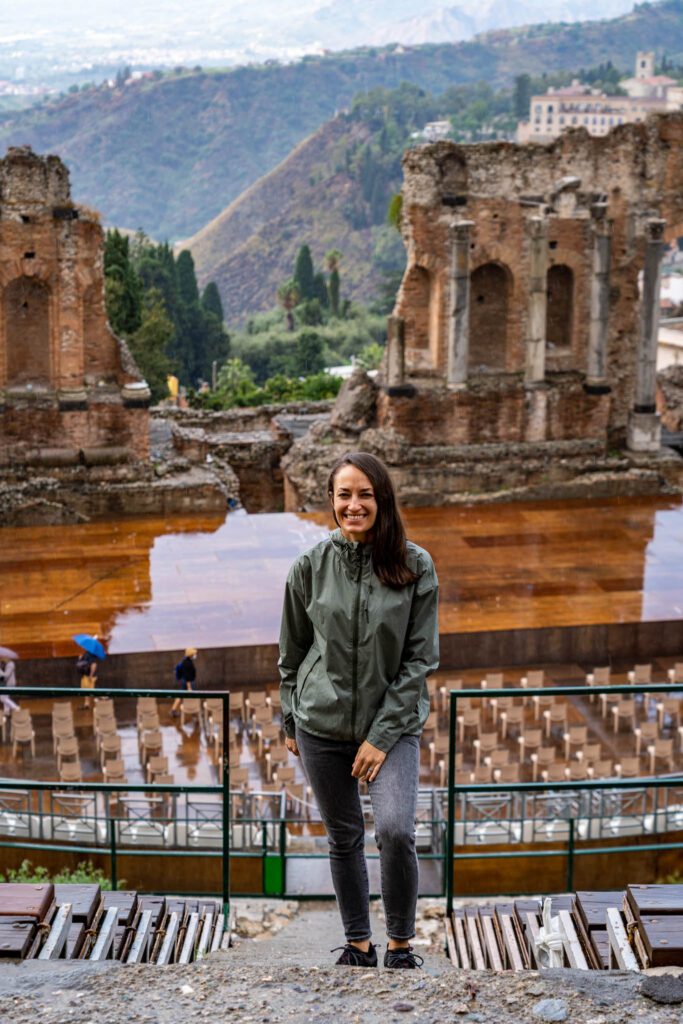
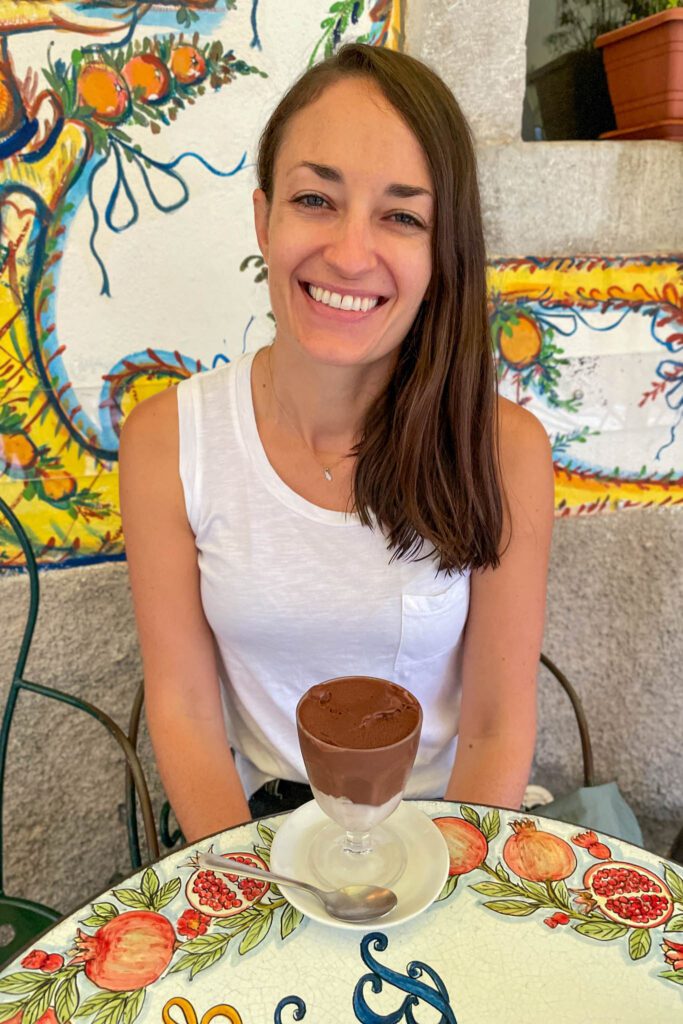
Day 3: Day Trip to Mount Etna (Stay in Catania)
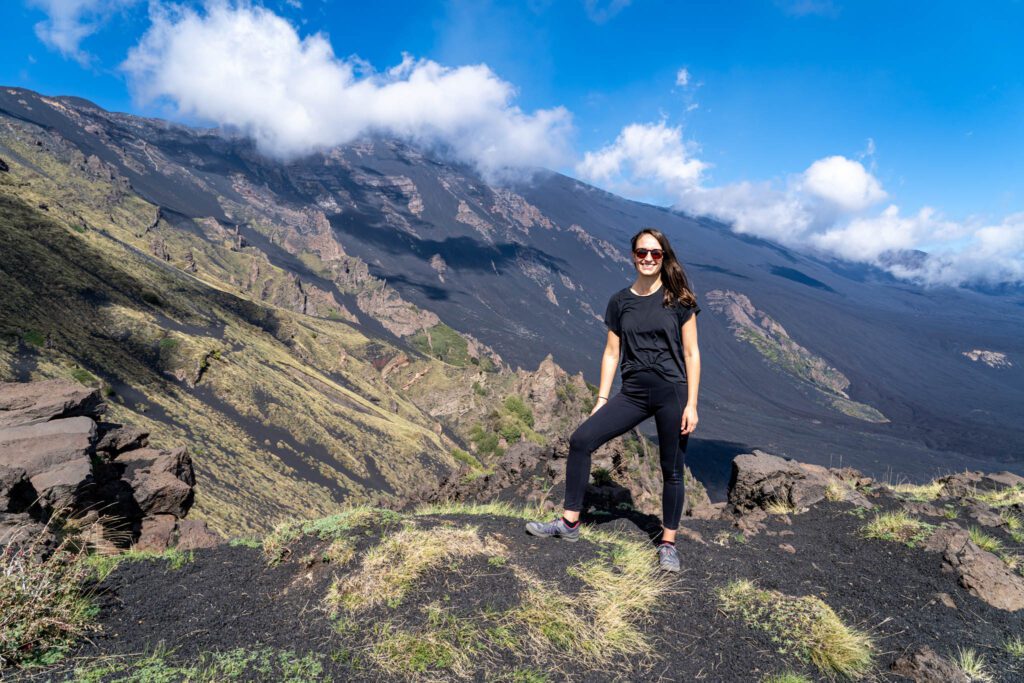
If you don’t have a car, you essentially have two options for visiting Mount Etna from Catania: go with a guided tour, or use the limited public transportation to get there and back and explore on your own.
The third option, which does involve a visit to the summit if you want – is only relevant if you have a car, and involves driving up to Rifugio Sapienza – which is essentially the gateway to Etna – and either meeting up with a guided summit tour that departs at 9:00 am, or exploring on your own.
There’s no doubt that this is probably the easiest, most convenient option for most people who want to visit the summit. But it also involves extra days of a rental car, parking in Catania, and parking in Syracuse, all of which are a bit of a nightmare.
Visiting Mount Etna on a Guided Tour from Catania
Ultimately, this is the option we chose to go with, and we’re generally pretty happy we did. These tours include transportation from the center of Catania, which is handy if you don’t have a car because, as we’ll cover in a second, public transportation is nearly nonexistent.
There are two types of tours to choose from – tours that visit the usual tourist areas, and tours that go a little off the beaten path. We chose the latter option, and were glad we did because we saw a total of eight other people over the course of the day (that is, until we got to Rifugio Sapienza and saw where all the people were).
If you want to hike and explore the area around Mount Etna, we did this tour with Marco, a Catania native, and would recommend it. The other option we had was this tour, which is very similar (but wasn’t available on the day we wanted to go).
If you’re not as excited about hiking, we’d suggest either this sunset jeep tour, or this day trip from Catania, which includes some hiking around the craters.
Visiting Mount Etna On Your Own

Keep in mind that, as we discuss this option, we’re talking about doing it without a rental car. Visiting Etna with a rental car is relatively easy – just drive to Rifugio Sapienza, park the car, and take the cable car up to do some hiking.
Without a rental car is a bit more complicated.
There is, at the time of writing, exactly one bus from Catania to Rifugio Sapienza, and one bus from there back to Catania. The bus leaves from near Catania Centrale at 8:15 am, and arrives at Etna at around 10:30 am. The bus back to Catania leaves at exactly 4:30 pm (16:30) and arrives back in Catania at around 6:30 pm (18:30).
As you can see, that timing is problematic if you want to meet one of those guided tours up to the summit, which leaves promptly at 9:00 am from the cable car station near the Rifugio.
Our recommendation based on research and a conversation with our guide is to pay the extra money for the cable car that takes you up to the craters. It’ll cost you 30 Euros for a roundtrip (return) ticket, but it cuts out a stretch of hiking that doesn’t sound enjoyable, particularly in the heat of the summer months. You could hike, and usually we’re pretty up for hiking, but this hike is neither scenic nor pleasant.
Once you reach the top of the cable car, you have two options. The option we’d recommend is hiking, which is more scenic, and is free. You’ll climb another 500 or so meters up to the craters, and this hike is more scenic because you’ll find yourself in the heart of the volcanic landscapes that make Etna such an otherworldly experience.
Here’s a fantastic guide to visiting Etna using public transportation that we’d recommend reading if you’re going to go this route.
Day 4 & 5: Syracuse & Ortigia
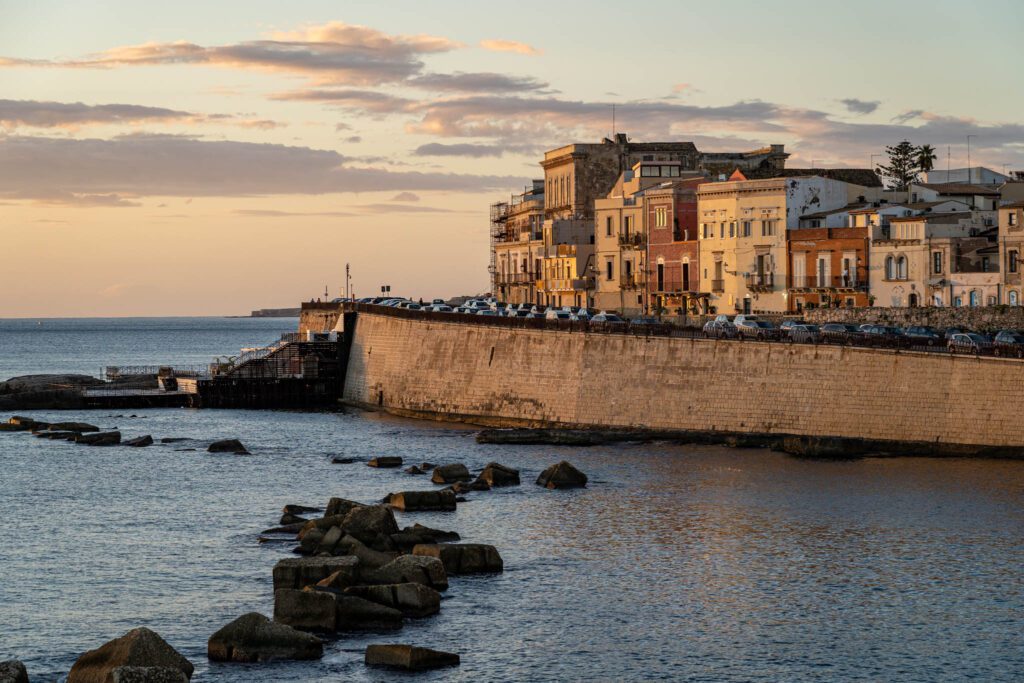
When it comes to my limited knowledge of eastern Sicily prior to starting to do research for our trip, Syracuse was one of two places I was familiar with. And the reason is kind of funny, and is actually fairly relevant.
Growing up, I used to play hours and hours of Rome: Total War, a video game where you set out as a faction in Europe (usually Roman) to build an empire (mostly through violence and betrayal).
Syracuse was always an important city in that particular game because it sat on an island – Sicily – that was a perfect base between Italy, Spain, North Africa, and Greece.
That also happens to be true in the real world. The city was founded by Greeks, and it became a very powerful player in the Mediterranean power game before becoming a part of the Roman Empire, and it was briefly the capital of the Byzantine Empire in the late 7th Century.
Then, it changed hands between the Aghlabids – a kingdom of Muslims from North Africa – who held it for two centuries before it was reconquered by the Byzantines.
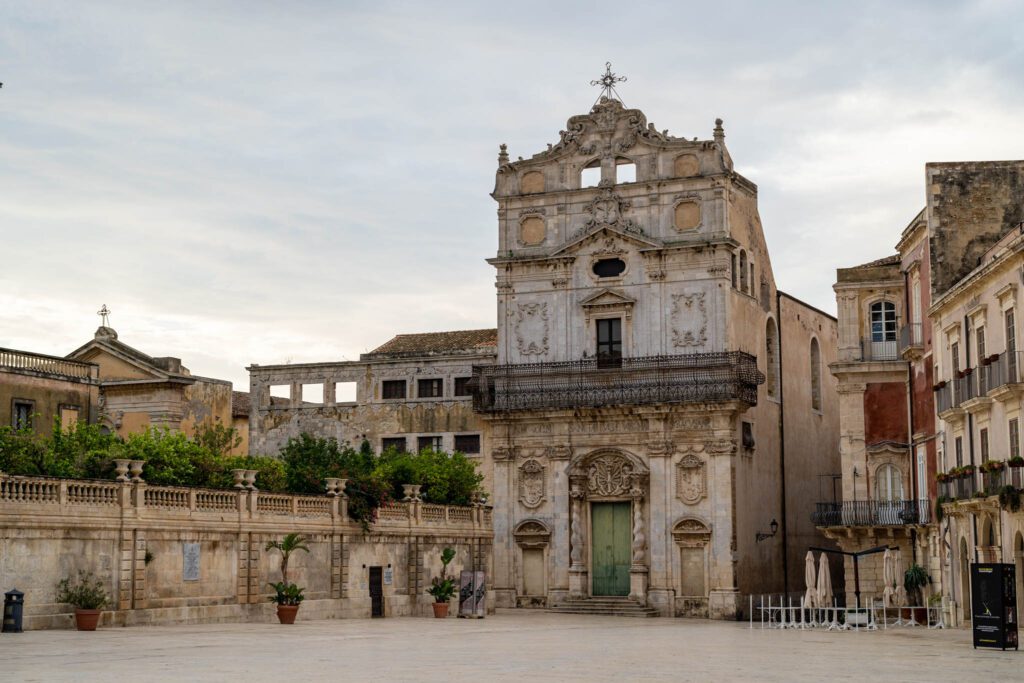
All of those influences are apparent as you explore the twin cities of Syracuse and Ortigia, from the prevalence of couscous in the cuisine (hailing from North Africa) to the ruins at the archaeological park that are great examples of Greek and Roman architecture.
Like most of eastern Sicily, the architecture of the city was changed forever with the earthquake of 1693, so you won’t see as many examples of those influences on the buildings of Syracuse since the city was essentially rebuilt in the 18th and 19th Centuries.
The entire city is now a UNESCO World Heritage Site, which has helped to preserve the city’s architecture from overdevelopment due to tourism. It’s one of the most popular tourist destinations in Sicily, so you’re likely to hear all sorts of different languages as you’re walking around. Especially if there’s a massive cruise ship in the port.

A Quick Geography Lesson
This is important, which is why we’ve decided to add a quick blurb here to make sure you know what we’re talking about below.
“Syracuse” refers to the city on the mainland, which is connected to a little island called “Ortigia” which is famous for its narrow cobblestone streets and magnificent sea views.
You’ll want to stay in Ortigia, which is the more charming, romantic part of the city, but the most important sight in Syracuse – the Parco Archeologico Neapolis – is on the mainland, about 30 minutes away from Ortigia on foot.
You’ll spend most of your time in Ortigia, with a journey out to the park to see the incredible Greek and Roman ruins found there.
Getting to Siracusa
Syracuse is another place that we’d recommend avoiding driving, and frankly, you won’t need a car anyway since it’s relatively compact – you’d essentially just park the car and leave it until you’re ready to head to your next destination.
Plan on taking the train from Catania Centrale to Siracusa (book through Trenitalia), or the bus through Interbus (you can pick up the bus from Piazza Borsellino, which is a short walk from Piazza del Duomo).
You should know that the train station in Syracuse is a good 20-25 minute walk from Ortigia, so you’ll either want to plan on walking or grab a taxi from the train station.
Things to Do in Syracuse & Ortigia
Here are some of our favorite things to do in Syracuse and Ortigia. We’re going to start with a section on the Parco Archeologico Neapolis – the most important and popular sight – and then give you some other things to do and see while you’re here.
Visiting the Parco Archeologico Neapolis
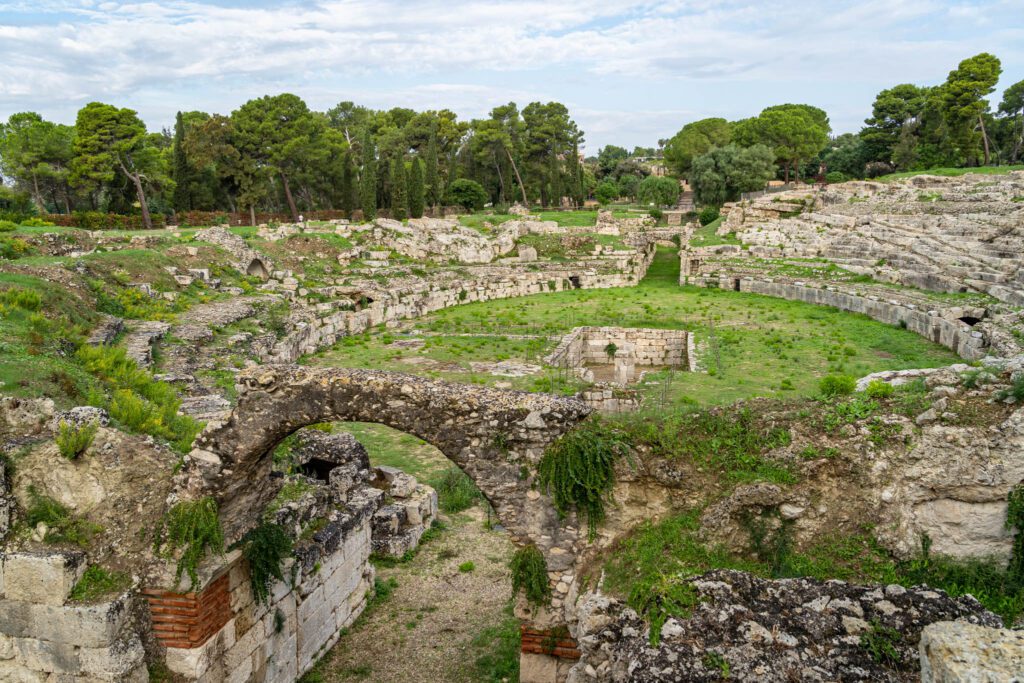
By far the most popular tourist attraction in the city is the Archaeological Park, where you’ll find both a Greek AND Roman theater, along with beautiful gardens full of citrus trees, limestone quarries, and more.
It’s well worth a couple of hours of your time, which is about the amount of time it will take you to walk through the three main areas of the park – the Greek Theater, the Roman Theater, and the limestone quarries and gardens around the Latomia del Paradiso.

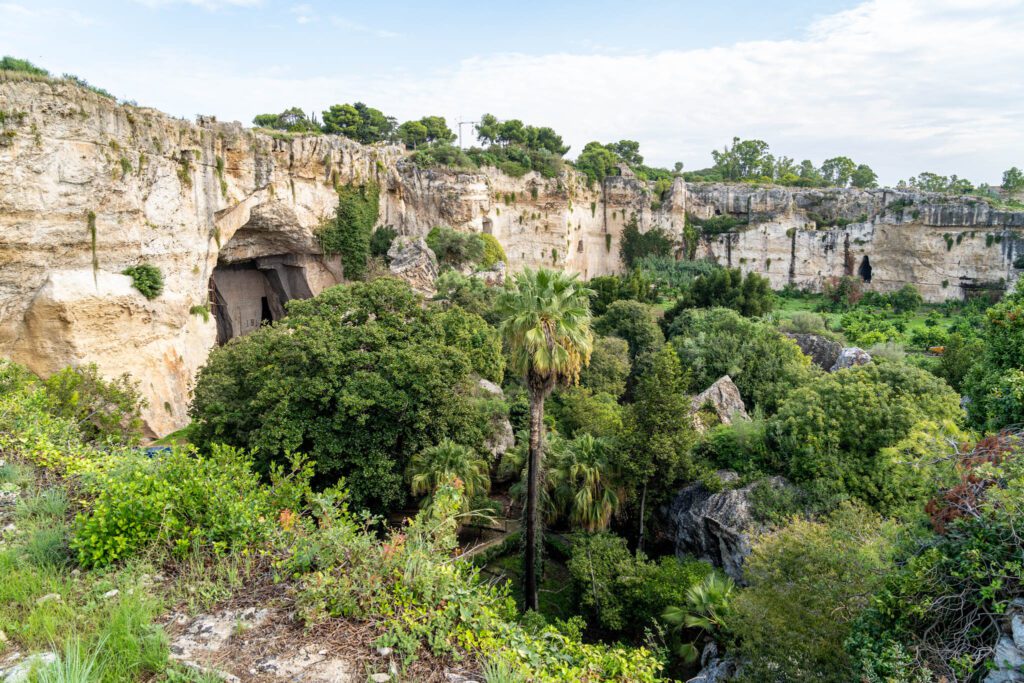
You can buy a combo ticket that includes the Museo Archeologico Regionale Paolo Orsi (about 15 minutes away on foot), which is worth a visit if you’re REALLY into archaeology, but we found it very overwhelming. It has literally hundreds of pieces of pottery from various eras, among other artifacts, though the pygmy elephant skeletons were adorable.
After the park, we didn’t really have the brainpower or attention span for it, but it might have gone better if we had split the two activities up on different days.
We’d highly, highly, highly recommend getting to the park at 8:30 am when it opens for two reasons. One, because it gets crazy busy starting around 10:00 am, which will give you a couple of hours head start to see some of the park in relative peace and quiet. Two, because in the summer it gets miserably hot and there’s not a whole lot of shade.
It costs 10 Euros per person for the park only, and 13.50 Euros for a combo ticket that includes the Museo Paolo Orsi.
More Things to Do in Siracusa and Ortigia
Here are some other things to do in Syracuse and Ortigia.

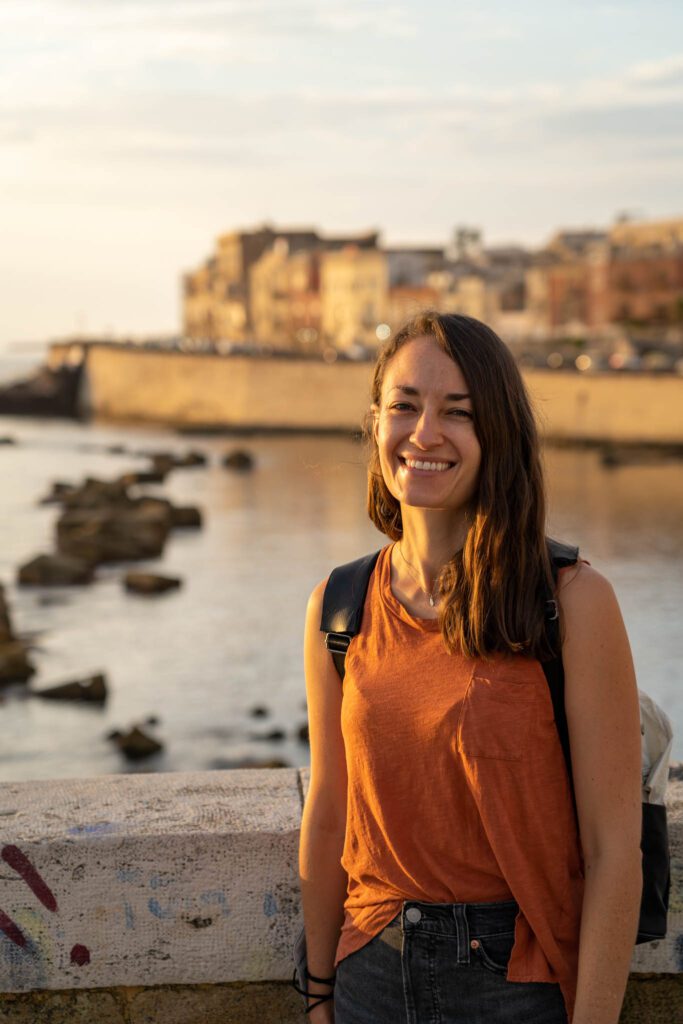
- Walk the Perimeter at Sunset: One of our favorite things to do in Ortigia was to just walk. And we ended up walking the entire perimeter of the island three times. It’s gorgeous, particularly in that sweet, soft light that happens within an hour of sunrise or sunset. It’d be a good pre-Aperitivo activity, and if you do it from the northeastern tip to the western end, you’ll be in a good position to grab a spritz at the end of the walk. Make a stop at the Castello Maniace along the way. Something like this would be a good route.
- The Underground Tour: There’s a fascinating and relatively quick tour of the Chiesa di San Filippo Apostolo in the old Jewish Quarter that takes you into the crypts below the church (which is built on top of a synagogue), and then into the underground tunnels that were used to shelter civilians during the Allied bombings in World War 2. Pretty fascinating stuff, and an interesting way to experience the history of Syracuse from a different point of view. Tours in English and Italian are roughly every half hour in the afternoon, and are donation based (we donated five Euros for the two of us).
- Gelateria Gusto: Incredibile pistacchio granita, though they’re also known for great gelato.
- Sabadì Cioccolato: If you’re not making it to Modica (if you follow this itinerary, you will), then you should stop by here to try some Modica chocolate, which we found to be amazing and slightly different from the chocolate we’re used to. It’s cooked slowly at a lower temperature, which means the sugar doesn’t dissolve, and they don’t add cocoa butter in. Combined, the result is a slightly grainy texture, which reminds me a lot of chocolate in Mexico that is stoneground. You can get it plain, or with all sorts of fun flavor combinations, and this place – which is right near Piazza del Duomo – is a good place to get an introduction to it with tons of flavors you can sample and buy.
- Aperitivo and the Sunset: Grab a drink around sunset (really, get there 30-45 minutes early to grab a seat) at one of the many bars along the southwestern tip of the island. Our picks would be Mikatu for their wines, but we got thwarted by thunderstorms BOTH nights we were there. Other good options without the view are Enoteca Solaria (for amazing wine) and Verga (for the picturesque courtyard and cocktails).

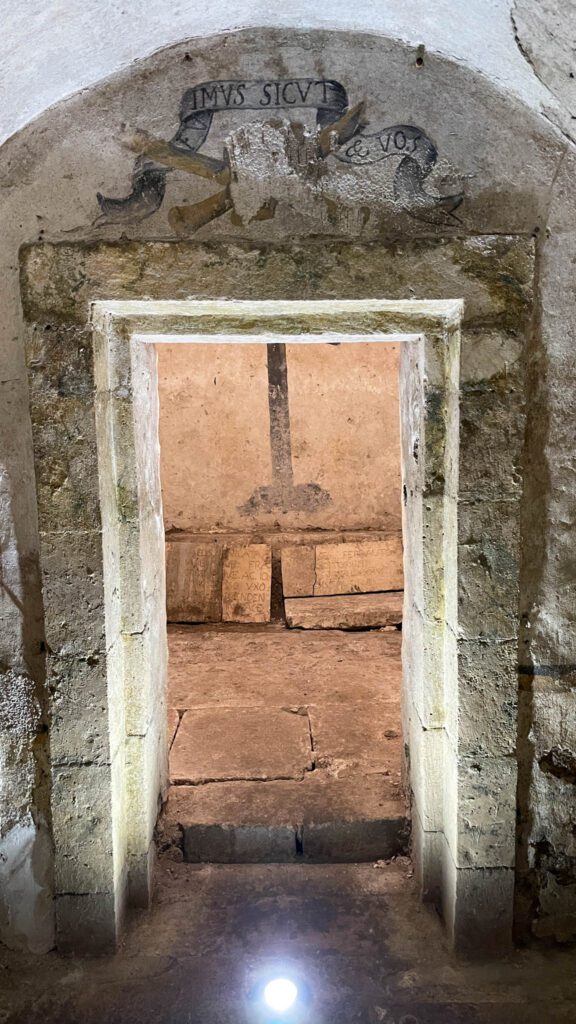
Where to Stay in Syracuse & Ortigia
It’s worth repeating: stay in Ortigia! Even if you’re on a tight budget, we think you’ll regret staying in the far less charming mainland area, even if you’ll save a few pennies.

We stayed at Stay in Ortigia Guest House, a group of stylish apartments right in the heart of Ortigia near the Temple of Apollo on a quiet side street. The apartments are compact, but have full kitchens, modern decor, and access to laundry (which we desperately needed at this point in our Italy trip). We’d recommend it, especially if you’re looking for an apartment with a kitchen.
Here are some other options that were on our shortlist for Ortigia.
- Alla Giudecca: We walked by this place multiple times as we did a circle around the perimeter of Ortigia at sunrise and sunset, and noticed the rooms with balconies facing the ocean and said “yeah, that looks pretty nice.”
- Dimore delle Zagare Ortigia: This is a historic B&B in the ever-charming Jewish Quarter of Ortigia, which was our favorite part of the island to get lost in. The location is great in terms of being central to just about everything you’ll want to see in Ortigia, and you can choose between hotel-style rooms and suites with a little more space (and, in some cases, a balcony!).
Day 6 & 7: Val di Noto
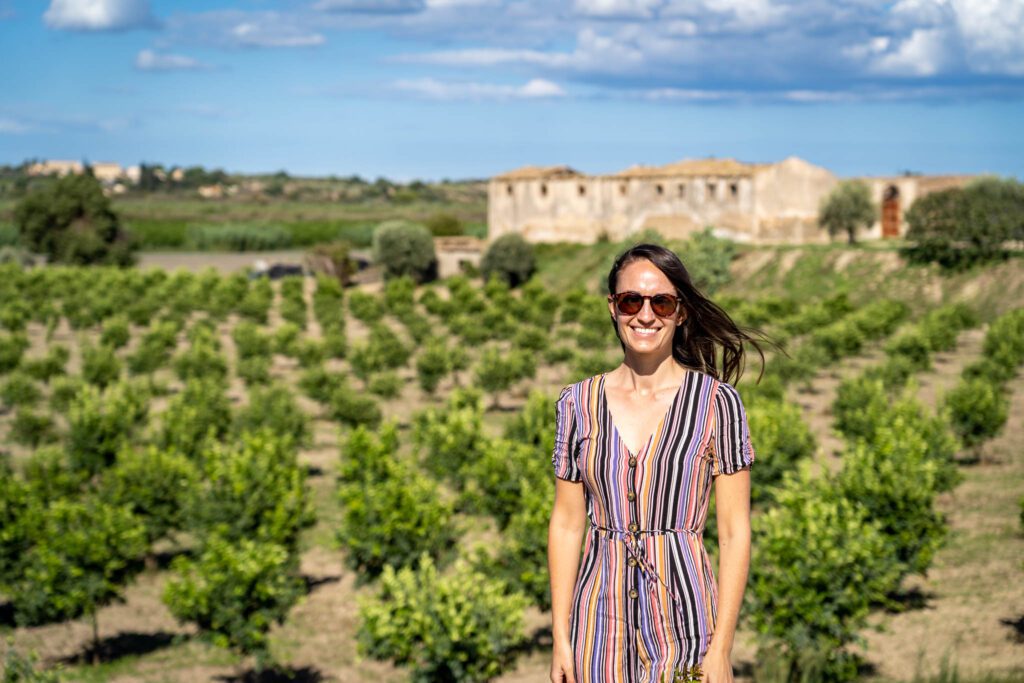
Drive Time & Distance: 40 Minutes / 38 km (remember, pick up your rental car in Syracuse on the morning of day 6, before your drive to Noto! You’ll need it from here to Palermo, where you can drop it off on your way into the city and explore car-free from there).
The Val di Noto is one of the crown jewels of southeastern Sicily, with the towns within the region being declared a UNESCO world heritage site in the early 2000s.
The city of Noto itself was completely destroyed during the 1693 earthquake, and was rebuilt in a completely different spot – you can actually still visit what’s left of the old town at Noto Antica, but we wouldn’t necessarily recommend it if you’re short on time.
Noto is the epitome of Sicilian Baroque architecture, which makes sense when you realize that the architects in charge of rebuilding the city after the earthquake in the 17th and 18th Centuries essentially had a completely blank canvas to work with.

We think there are three amazing things to see in the Val di Noto, and it’s well worth about 36 hours of your time (and certainly more, if you have it). They are:
- A morning hike to the beaches in Riserva di Vendicari
- An afternoon in Marzamemi, a small fishing village on the coast
- An afternoon and evening in the city of Noto, which is known for its beautiful baroque architecture made of limestone, which lights up in the afternoon sun.
What to Do in the Val di Noto
As you can see, there are two afternoon/evening activities there, which means you’ll need two nights in the Val di Noto.
Here’s how we would spend them.
Exploring the Town of Noto
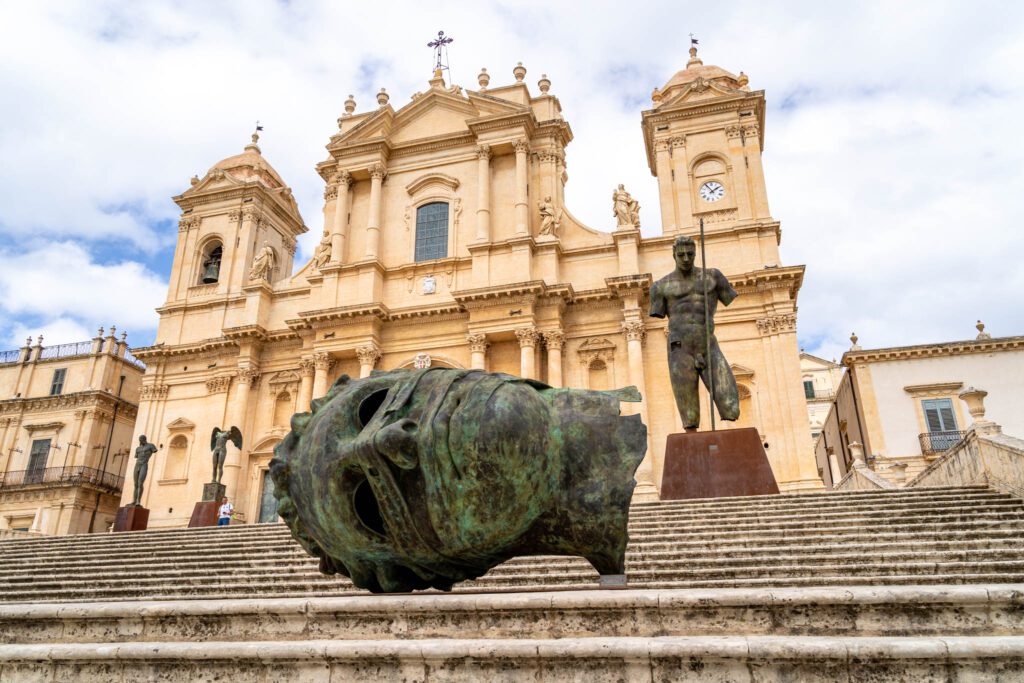
Spend your first afternoon and evening exploring the city of Noto, which is set on a hillside overlooking the valley to the south. Don’t miss:
- Caffè Sicilia: This place is famous for their almond granita, and I wasn’t sure whether or not it would live up to the hype. Spoiler: it does. They have a version of it called a “cappuccino” where it’s a small scoop of coffee granita on top of a heap of almond granita. The almond granita is great, and their pastries look pretty incredible too.
- Putia del Coppo: A cone full of freshly caught fried fish. All gluten free! They go on holiday from… *checks notes*… October to April, so it’s really a summer thing. They also have a location in Modica.
- Cattedrale di Noto: We’re not usually huge “go into all the churches” people, but this one is pretty cool. Inside, the stained glass windows underneath the dome caught our eye, as did the super realistic paintings depicting the passion of the Christ (aka the crucifixion), which I thought was an interesting take because you can really feel the suffering of Jesus through the art. Make sure your shoulders are covered and take off your hat as you enter.
- Walk Something Like This Loop, which takes you up some stairs to some nice views. Obviously, you’re exploring, so feel free to wander a bit.

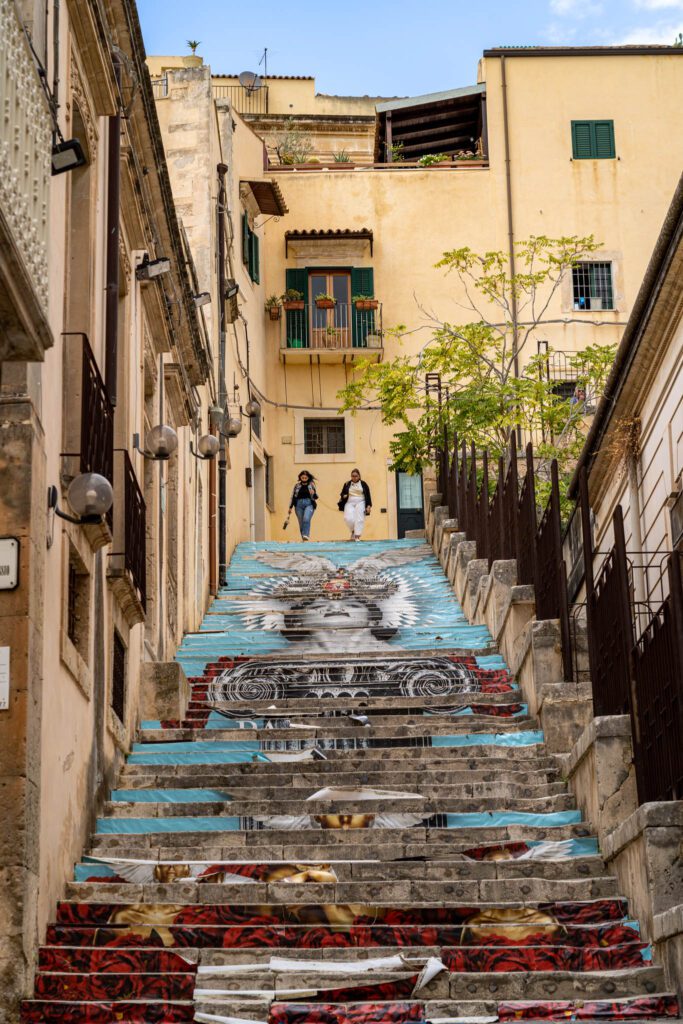
Parking in Noto: We found plenty of free street parking in Noto near this gas station, which is a 10-15 minute walk up into the center of town. We had also scoped out this parking lot, which isn’t free, but is affordable and super close to the center.
The Vendicari Reserve

The next morning, head out to the beaches in the Vendicari Reserve, which was highly recommended to us from the hosts at our little B&B in the countryside.
It’s a little more complicated than “head to the beach!” because there are multiple ways to get there, entrances, etc.
Basically, there are three main beaches in the reserve: Spiaggia di Vendicari, Spiaggia di Calamosche (the prettiest and busiest), and Spiaggia di Marianelli (the naked-est).
So, after driving down a narrow dirt road and finding nobody there to take our money to park (it was the offseason, so I bet it’s different than the summer), we have a recommendation: head straight to the main entrance (here – ignore the single bad review, at the time of writing, it’s 3 Euros to park for the day, which is reasonable for this area) and walk to the beaches from there.
It’s a scenic walk along the coast, and it is well worth the effort to get there. It will save you the headache of trying to navigate the bad roads in a rental car, and the walk itself is gorgeous.
It costs 3.50 Euros per person to enter the reserve (plus the parking fee), and you’ll want to bring plenty of water because it is completely exposed and it can get very hot in the summer heat.
An Afternoon / Evening in Marzamemi

After an afternoon of hiking and exploring the beauty of the rocky coastline, sandy beaches, and stunning crystal clear water of southern Sicily, head to the small town of Marzamemi for an evening of relaxation. Our host at our little farm stay recommended this, otherwise we probably never would have done it on our own.

The town doesn’t really come alive until at least 7:00 pm, so it might be worth heading back and cleaning up a bit before returning. It’s a tiny town, so there’s not really that much to see, but we’d recommend finding a spot for aperitivo and dinner around Palazzo di Villadorata, which was the liveliest part of town when we were there.
Parking in Marzamemi: We were there in the offseason and found plenty of street parking for free, but if you can’t find free parking, this lot is highly reviewed and is a couple of blocks away from the heart of the action.
Where to Stay in the Val di Noto
We’re going to recommend that you actually stay outside of the city of Noto itself, because the Val di Noto is absolutely breathtaking, with tons of agriculture, wine production, and beautiful beaches awaiting you outside of the city limits.
There are lots of agriturismos, where you can stay under the olive, pomegranate, and almond trees, slow down, and really appreciate the beauty and productivity of this part of southeast Sicily.

We stayed at Fiori di Noto, a small, family-run agriturismo just outside of the city of Noto, and highly, highly recommend it. We spent half a day just lounging in the sun under the olive tree outside our bungalow in the company of the cutest bunch of kittens, and it could not have been more pleasant.
It’s also about 10 minutes from Noto, and under half an hour to Vendicari, so it’s not like you’re really trading off on the location. Plus, free parking!


Three other options (that look fantastic) just outside of Noto:
If you want to stay in Noto, stay at either the Ostello della Gioventù – Il Castello, a hostel with private rooms right in the heart of town that we walked by on our afternoon stroll, or B&B Novecento Siciliano, a charming bed and breakfast just off of Noto’s main drag.
Day 8: Modica & Drive to Agrigento

Drive Time & Distance (Including Modica): 3 hours / 186 km
This day is the big driving day on this itinerary, and over the course of the day (and the next drive to Trapani) you’re going to pass through huge swaths of the island that are extremely picturesque, with vineyards and almond trees covering rolling hills as far as the eye can see.
However, there just isn’t enough time to stop and see everything, so we’ve chosen Modica as a perfect stop to break up the drive. We spent a lovely four hours in Modica, and there’s a nice city walk that we’d recommend (more info below) where you’ll get some pretty incredible views.
The views come with a price, though. And that price is a long, sometimes steep climb straight uphill.
Like most cities in eastern Sicily, Modica was devastated by the 1693 earthquake (though less so than other cities like Noto), and was rebuilt in the Sicilian Baroque style you’re now probably intimately familiar with.
Modica is really a combination of two cities – Modica Bassa (roughly, “lower Modica”) and Modica Alta (roughly “upper Modica”). Modica Alta is at the top of the hill, and the views from atop the crest of the hill are pretty great.
The only problem is that it’s a nightmare to drive up to them, and the best way to reach the top of the hill is actually to park at the bottom and walk. Which is exactly what we’d recommend doing.

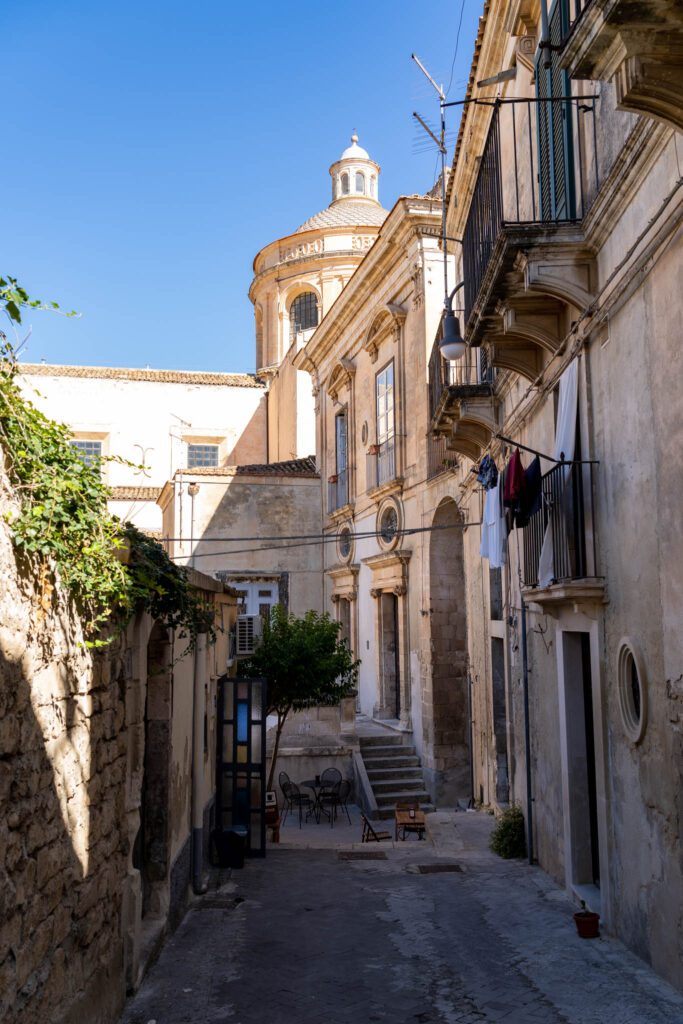
Below, you’ll find a city walk that mirrors what we did, including some of our favorite stops along the way. After you’re done in Modica – plan on anywhere between two and four hours, depending on how much walking you’re up for – head onwards to Agrigento for the night.
Parking in Modica: There’s a small, free parking lot here that we parked at – in high season, you’ll need to arrive EARLY (like, 8:30 am early) to have a chance at a spot. Otherwise, there’s lots of paid street parking near that parking lot at a relatively affordable rate. Pay at the machine and put the ticket on your windshield.
What to Do in Modica: A Nice City Walk
First of all, here is a map of this city walk, including all the stops we’ve outlined below. You’re going to climb 166 meters over the course of the walk, mostly along narrow alleys and steps. Take your time, and make sure you have plenty of water.
Here are the stops, in order. You’ll start from the parking lot we mentioned above (or wherever you found parking nearby), and make your way up the hill to Pizzo Belvedere before heading back down and enjoying some cheese, gelato, and chocolate that will have been well-earned.

- Duomo di San Giorgio: This church – designed in the Baroque style, of course – was restored in the 18th Century after a series of earthquakes, and is now the main church in Modica, with its distinctive dome visible from all over the city. Similar to Noto, I enjoyed the paintings depicting the crucifixion of Christ, which are surprisingly realistic (apparently that was a characteristic of the times).
- Cioccolato di Modica Sabadì: Chocolate made in the traditional Modica way: cooked at a low heat so the sugar doesn’t dissolve, which gives it a slightly gritty texture. This shop has a table with a bunch of different chocolates on it – some flavored, some just chocolate, some with flavor combinations inspired by different cities in Sicily. We really enjoyed learning about the process of making the chocolate, and about the different product lines they have. Plus, free samples!
- Pizzo Belvedere: You made it! This is the top of the hill. Admire the views over Modica Bassa from here, and the huge bridge in the distance. We think the view from here is well worth the effort it takes to get there.
- Church of Saint John Evangelist: We stumbled upon this gem on our way down the hill. It’s beautiful, and marks the highest point in Modica Alta (so, technically, we lied when we said you were at the top before – forgive us). Inside, it’s not the most ornate, but we like the view from down the steps in front of the church. At the bottom of the steps, there was a small group of old men having coffee and chatting, gesticulating in a way that only Italians do, as they discussed either football or politics – hard to tell which. Getting together there was clearly a routine, which I admire.
- Castello dei Conti: Not the greatest castle in the world, but we enjoyed walking out to the point where there’s a clock tower that you can hear ticking (loudly). Views from Pizzo Belvedere are better.
- Bar del Duomo: In an alley right under the Duomo di San Giorgio, this is a lovely place to stop and have an espresso, granita, or pastry before you continue on down the hill.
- Antica Dolceria Bonajuto: Said to be the oldest chocolate shop in the city, this will be a fun stop if you, like us, have a love affair with chocolate. They also have tours, though you’ll need to book in advance and they cancel it if they don’t have at least six participants. The friendly woman behind the counter spoke great English too, which was helpful as we tried to figure out what the things in the display case were.
- Caffè Adamo: Famous for their gelato, Alysha knew she had to try this place as soon as she discovered it. She is, after all, a gelato fiend. I passed because I wasn’t sure how “gluten free” their gelato was. She tried a ricotta + marjoram gelato, which was super creamy and some of the best she’s had in Sicily (though, we’ve been far more focused on granita while we’ve been here).
- Casa del Formaggio Modica: Is the man behind the counter the nicest cheesemonger in the world? We think so. We walked by and decided to stop in, and walked out with two cheeses and a bottle of local wine. The man behind the counter gave us recommendations for a hard and stinkier (the technical term, of course) cheese, and helped us choose a bottle of wine. He made sure we tried the cheeses before we bought them so we were sure we’d like them, and they were fantastic.

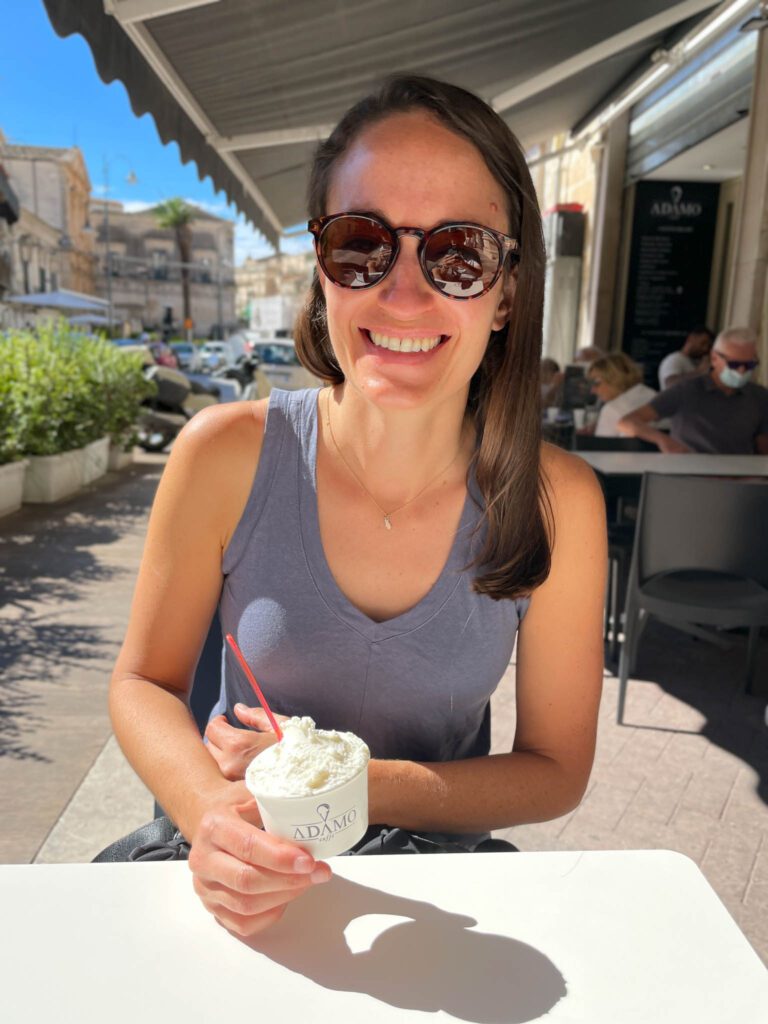

Day 9: Agrigento & Valle dei Templi
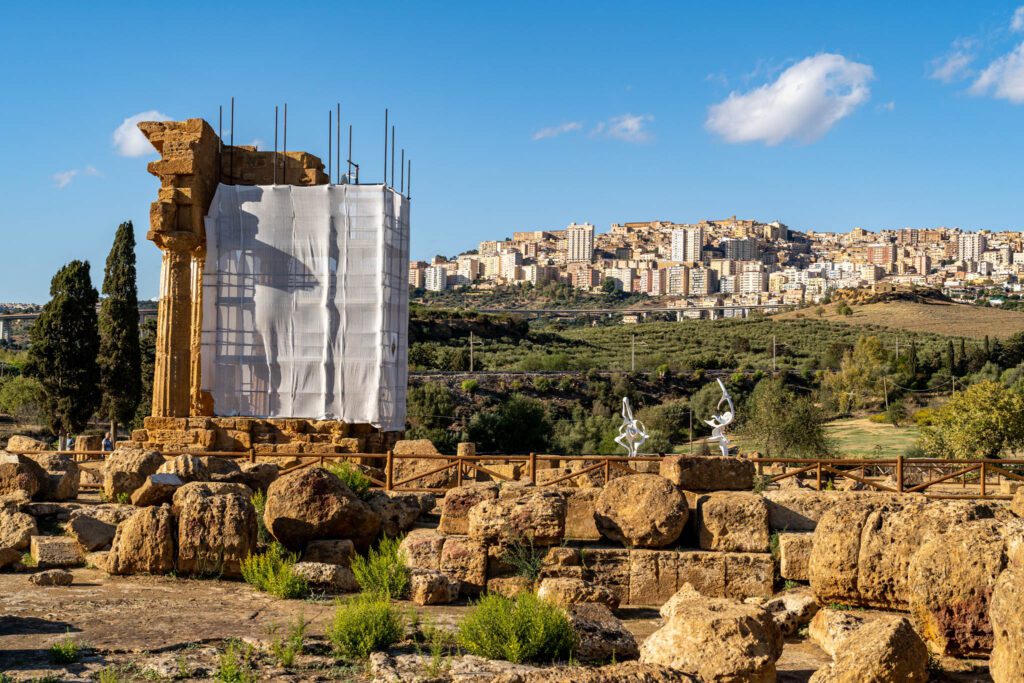
You’ll have arrived in Agrigento the previous afternoon after a morning in Modica, and we’d recommend spending your first evening in the center of Agrigento, which comes alive when the sun sets.
We grabbed a drink at Caffè San Pietro right in the heart of Agrigento, and it was a lovely place to people watch with spritzes in hand, and a generous bounty of aperitivo snacks. There are plenty of places to choose from for dinner in the area, though we heard really good things about Enoteca ‘Nzolia.

Then, the next day, the main event: visiting the Valley of the Temples (more details on that in a second).
Where to Stay in Agrigento
This is another place where we’d actually recommend staying on the outskirts of town, where you’ll find some very nice B&Bs with lush gardens and spectacular views.

We stayed at Villa La Lumia B&B, which is just outside of town, about a 20 minute walk into the center, and we LOVED it. The hosts were so friendly, their dog Argo is absolutely adorable (we almost stole him, shhhh don’t tell anyone), and the breakfast on the terrace with temple views is quite the way to start your day.
It’s a lovely place to hang out, and we can’t recommend it enough. They have hotel-style rooms, and apartments that have a kitchen. Free parking, too.

Other good options just outside of town are Villa Lekythos or South Valley Guesthouse.
If you want to stay in the center of Agrigento, stay at either B&B Triskéles, which looks fantastic, or at Le Terrazze di Pirandello, a good budget option with room options that have a shared bathroom for a bit cheaper.
Visiting the Valle dei Templi (Valley of the Temples)

Over the course of the next 36 hours or so, you’re going to see three examples of ruins of ancient temples and cities built around them. This one, which is about a 20 minute walk outside of Agrigento, was hands down our favorite, and maybe even our favorite thing we did in Sicily.
We were standing at the entrance to the Temple of Zeus reading the informative signage (in English!), which outlined for us where the walls of the temple would have stood.
Both of us turned to each other and audibly said “whoa” because that temple must have been absolutely MASSIVE.
Of course, you’ll have to use your imagination a bit to picture it, but the scale and grandeur of some of the structures in this area is pretty mind boggling.
How to Get There
The archaeological area spans a pretty big distance, and there’s an entrance on either end of the park with plenty of parking (though you’ll have to pay for it). If you’ve got a car, you can drive to the Valley of the Temples, and you’ll have to pay for parking.
However, this means that you’re going to have to walk through the valley once to see it all, then back through it again to return to your car. We recommend either walking, which takes about 30 minutes in either direction, or taking the bus, which leaves from here.
That way, you can make a big loop without having to retrace your steps. There are two routes you need to make this loop. You take the 2 bus to get to the eastern entrance, then pick up the 1 bus from the western entrance to get back to Agrigento – buy tickets on the bus.
More information on their website in the “visit” section here.
Ticket Costs
A standard ticket costs 12 Euros per person. A combo ticket with the Kolymbethra Garden, a former lake turned lush valley filled with citrus trees, costs 17 Euros (the garden closes earlier than the Valley of the Temples, so you’ll want to do it first).
A combo ticket with the nearby Archaeology Museum costs 15.50 Euros (you can visit them over the course of three days, one admission to each).
More information here.
When to Visit
We have a strong opinion on this one, and it’s shared by the host at our B&B that we stayed at in Agrigento (which we highly recommend – it’s Villa La Lumia B&B).
You should go in the late afternoon, about an hour and a half before sunset, when the light of the setting sun lights up the temples in a deep golden glow.


Plus, the park is open past sundown, and if you’re willing to wait a bit, you can have a completely different experience with the temples in the dark, when they’re lit up with fancy uplighting.
If your itinerary makes it so that you can’t swing an afternoon/evening visit, it’s still worth doing at other times of day, but it’s that much more spectacular as the sun is setting over the sea beyond the temples.
Day 10: Selinunte, Segesta, and Drive to Castellammare del Golfo

Drive Time & Distance: 2 hours 40 minutes / 180 km
This is another day with a long drive, but we’ve got a couple of nice stops along the way to break it up. Eventually, you’ll arrive in Castellammare del Golfo, a charming little seaside town that is a great home base for exploring one of the best nature reserves on the island.
Like we mentioned before, there are a bunch of really fascinating historical sites in this part of Sicily. You’ll see two of them today (combined with the Valley of the Temples last night, this is quite the 24 hours of history).
One of them – Selinunte – is about the historical context and using your imagination to envision what life in Sicily was like in the Greek and Roman times. The other – Segesta – is about the sheer beauty (there’s not a whole lot of historical context given).
The order goes: Selinunte, Segesta, then driving to Castellammare del Golfo.
Selinunte

Let me tell you, after you’ve seen all three of these archaeological sites, you’re going to walk away with a new appreciation for the ancient people’s ability to choose a site for their cities and temple complexes.
Selinunte sits on a bluff overlooking the sea, and the views are pretty fantastic, particularly from the portion of the park where you’ll find the acropolis.
We had heard of both the Valley of the Temples and Segesta before arriving in Sicily, but this one was something we discovered along the way, and decided to make a very slight detour to include it on our route.
Selinunte is a pretty big archaeological park set on the site of a Greek city dating back to the 600s BCE. It was one of the most important pieces of land for the Greeks in Sicily at that time, and they butted heads with both the Carthaginians and the Elymians, who came from the Segesta to the north and are one of three native peoples of Sicily.
It was a thriving city in what we now know as southwestern Sicily, that is until Carthage sacked it, razed it, executed many of its inhabitants, and then re-occupied it in 409 BCE. It was then taken by the Romans in the Punic wars, but by then it was largely uninhabited.

Today, the collection of ancient houses around the acropolis and the two temple complexes were among the most interesting history lessons we got during our time in Sicily.
It’s a good reminder that this part of the world has a variety of influences, and has been occupied by several different groups of people throughout its history, all of whom have left their stamp on it in one way or another (though, it should be noted that some of those stamps – particularly the architecture kind – were wiped from the face of the earth with the earthquake in 1693).
There are two parts of the park, and you can either walk between them (think 15-20 minutes, there and back) or pay a small fee to ride the golf cart between them.

The first, right near the entrance, is a series of temples (though, unlike the Valley of the Temples, historians and archaeologists aren’t quite sure who the temples are dedicated to).
The second part of the park is over on a little bluff, and is where you’ll find the acropolis, more temples, and the remains of houses from thousands of years ago, which is kind of cool and helps you visualize what life might have been like at that time.
How to Get There: Drive – it’s about a 15 minute detour off the route you’d be taking anyway. Park for free in the big lot outside the entrance.
Ticket Costs: 6 Euros per person.
More information here.
Segesta

To be honest, this was our least favorite of the three temple complexes in the past day or so of this itinerary. It’s beautiful, yes, but the signage leaves a bit to be desired. Mostly because the answers to questions like “who built this?” and “why does this temple exist?” are basically the shrug emoji.
There’s a lot of hypotheses, but we don’t really know the details, because we only have primary sources from other people’s points of view – namely Greeks – and other than that… *shrugs*.
The two main highlights here are the Theater, high up on the hillside, and the unfinished Doric Temple, which is an easy 250 meter walk from the entrance.

It’s worth noting that the theater is quite a ways up on the hilltop, which means amazing views, yes, but it also means a climb to get there.
We’d recommend paying the extra few Euros to take the bus up, because the climb is brutal, especially in the hot summer sun. We walked, and we’re generally into hiking, but at the top we decided it wasn’t really worth it.
There are some nice views of the Doric Temple from the climb up, which is why we’d also recommend that you walk back down rather than taking the shuttle.

There really isn’t a whole lot to see here, so it should only take you 30-60 minutes or so.
Ticket Costs: 6 Euros per person.
More information here.
Where to Stay in Castellammare del Golfo
Unlike some of the other places on this itinerary, you definitely want to stay in the center of Castellammare del Golfo, rather than outside of town. The narrow streets near the port and along the water are very charming, and the areas further inland aren’t.
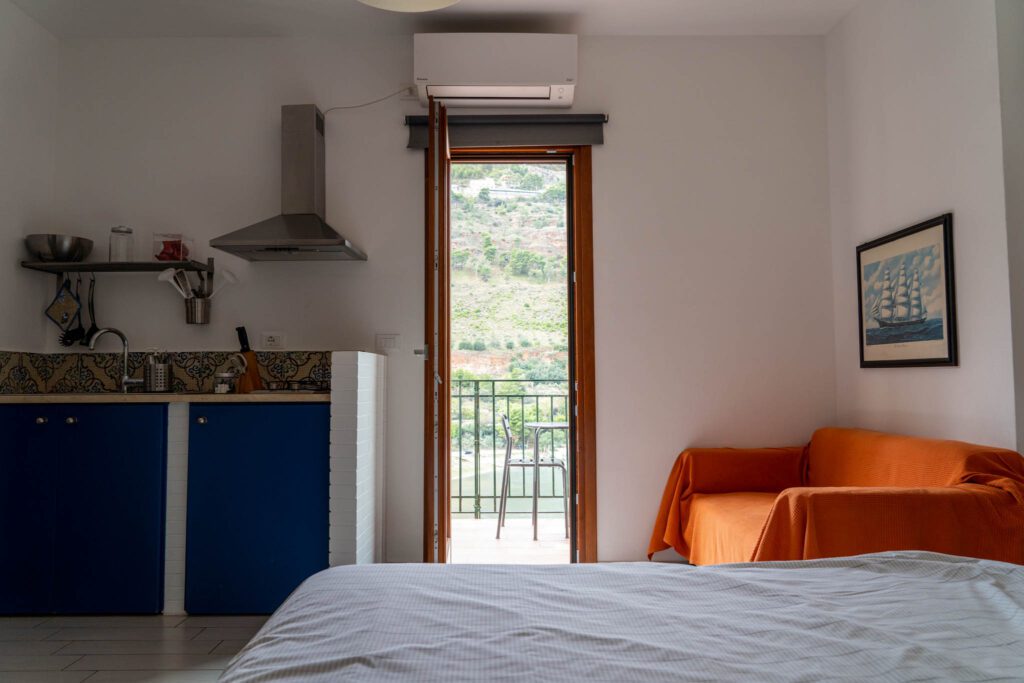
We stayed at Veranda sul Porticciolo, a small apartment complex run by friendly Guiliano, who showed us our room and gave us some tips about visiting the Zingaro Reserve, along with where to eat in town. We stayed in a studio, which was compact, but had a full kitchen, access to a washing machine, and a comfortable bed.
The best part was morning coffee and afternoon glasses of wine out on the deck, which has views of the port. Parking would be a bit of a hassle in the summer, when the area is a ZTL and you can’t park here, but that’s true of basically any place to stay in the center of town.
Other options nearby would be Hotel Punta Nord Est (for hotel-style rooms with nice sea views), Blue Suite (for spacious apartments with full kitchens and nice views), or B&B Da Peppa (a charming B&B with a rooftop terrace where you can enjoy your breakfast in the morning).
Day 11: Day Trip to Riserva Naturale Orientata dello Zingaro

Drive Time & Distance: 20 Minutes / 12 km (one way)
On this day, we’d highly, highly recommend taking a day trip to the Riserva Naturale Orientata dello Zingaro, which was a highlight on our Sicily trip. You’ll do the reserve – ideally in the early morning to avoid the blistering summer heat – and then spend the rest of the afternoon and evening in Castellammare del Golfo, which was our favorite town in this part of Sicily.
The pristine coastal reserve was established in the 1980’s after it had originally been slated for development – you walk through the tunnel where the road was supposed to go as you enter the reserve from the southern entrance.
But numerous environmental organizations stepped in to prevent the construction of the road and keep this part of Sicily’s gorgeous coastline wild.
Spoiler alert: they succeeded, and Riserva Naturale Orientata dello Zingaro became Sicily’s first nature reserve, protecting 4,000 acres of natural beauty on the northern coast.
Getting to the Park
Drive. There’s no other way to do it (that we could find, anyway – let us know if you find a bus with a reliable schedule!) which means if you don’t have a car, you’ll have to skip it. There are two entrances – one near Scopello on the south end, and one near San Vito Lo Capo on the north end.
The southern entrance is about 20-25 minutes away from Castellammare del Golfo, and is the one you should shoot for. Here it is on Google Maps.
The road to get there, uh, isn’t great. But it’s doable, even in a rental car. There’s a medium sized parking area that we imagined becomes a zoo in high season.
Costs and Hours
Entry to the park is 5 Euros per person, and they take both cash and credit card. In the summertime, the park is open from 7:30 am to 7:00 pm. In October, when we were there (and through the rest of the offseason until April), the park is only open from 8:00 am to 4:00 pm.
What to Do in Riserva Naturale Orientata dello Zingaro

Now, our experience in the park is likely a bit different than yours is going to be, at least if you’re coming during the warm summer months.
We were there in mid-October, and ended up out on the coast in the middle of a thunderstorm, with raindrops that felt like they were the size of my head. Not ideal, but still gorgeous in less of a “crystal clear turquoise water” kind of way, and more of a “those waves crashing on the cliff are a little scary” kind of way.
Start from the southern entrance and head north into the reserve. There are multiple trails to follow, but if you’re looking for those stunning coastal views and beaches, you want the coastal route, which is also the easiest. You’ll receive a map as you enter, which has all the “calas” you’ll find along the trail.
If you’re expecting wide sandy beaches where you can lay out in the sun, think again. It’s more rocky and wild than we were expecting, though that has never stopped Italians from getting their sunbathing in as far as we’ve ever seen.
If you’ve ever been to the west coast of the United States, which is where we’re from, the beaches here are more similar to the ones in Washington State – wild and rocky – than Southern California – developed and sandy.
The hike from the southern entrance through to the northern entrance is roughly 7km, so a 14km hike round trip. It should take you between four and six hours, depending on how many stops you make along the way. Here is a map of the reserve.
If you’re like most people, you’re probably visiting between June and September, when the weather will be significantly different. One thing we noticed on this route – mostly because we got soaked – is that there’s very little cover from the sun (or rain in our case).

Things to Know Before You Go
Here are a few things to know before you go to help you prepare for your trip.
- You need to bring plenty of water (at least one liter per person, if not more), sunscreen, and a hat. It’s going to be hot, and there’s not a whole lot of shade.
- There is no drinking water inside the park, and the only place to buy food or water is the little snack shack in the parking lot. Make sure you have enough snacks and water before setting out on the hike.
- Start early. Both because the parking lot is small, and to avoid hiking during the heat of the day.
- Wear closed toed shoes! The hike isn’t necessarily hard, though there is a little up and down as you make your way along the coast, but there are parts that are rocky. Leave the sandals at home. They will check whether you’re wearing proper footwear at the entrance, though it’s unclear whether they’d actually turn you away, or just laugh at you.
- The closer you go to the middle of the reserve, the fewer people you’ll find. Solely because it’s a longer walk from either entrance, and, well, people don’t like walking that much.
Days 12 – 14: Exploring Palermo
Let me give you a little BTS (behind the scenes) look at how we operate when we’re on the road. Generally, things are most fresh in the few days after we do something, so we do our best to actually write these guides in that timeframe (or, at the very least, take some detailed notes).
We are writing this guide as we make our way through Sicily, which means things change as we discover new places and gain a new point of view on certain things.
Originally, we had planned this itinerary out to include less time in Palermo, and more time on the coast in Western Sicily – specifically Trapani. Then we spent time in Palermo, and decided “you know what? More time in Palermo is always a good thing!”
That’s how we landed at having two to three days in Palermo, which is barely enough time to see everything there is to see, eat everything there is to eat, and do everything there is to do.
What to Do in Palermo
With a couple of days in Palermo, we’d strongly recommend prioritizing activities inside the city limits, rather than venturing outside the city to visit places like Monreale or Cefalu.
Here are our favorite things to do (and eat) in Palermo.

- Explore Palermo’s Famous Open Air Markets: There are three main markets in Palermo, and all three are worth a visit for different reasons. Go in the morning, which is when they are most lively (with the notable exception of Mercato Vucciria, which is decidedly a nighttime endeavor). Capo is a sensory overload, with vendors selling fresh fruit and vegetables, seafood, ready-to-eat fried delicacies, and plenty more. Mercato Ballaró, south of the historic center, feels REAL, with a touch of grittiness that tells me that real people shop there for their daily needs. Mercato Vucciria is a collection of narrow streets that we stumbled upon after dark (mostly by accident), when the area transforms into a collection of small food stalls and cozy bars with plenty of open air seating.
- Eat Street Food in Palermo: Palermo is world-renowned for its amazing street food. You can pretty easily eat a hearty, authentic meal for about five Euros. Some of our favorite Palermitan street foods were Crocchè, which are herbaceous deep fried mashed potatoes, and arancine (interestingly, the singular in Palermo is “arancina”, versus “arancino” over in Catania), which are basically fried rice balls stuffed with all sorts of fillings, from veggies to meats and cheeses. Or sfincione. Or panelle. The list goes on and on. The point is, Palermo has amazing street food. The best way to experience it, we think, is with a local guide. This is the tour we had planned to book – despite the fact that I have Celiac Disease and couldn’t eat a single thing, I was excited to learn all about Palermitan culture – but the timing ended up not working out and we didn’t get a chance to do it. Book the morning tour, and show up hungry!
- Learn About Palermo’s History with the Mafia: Having never seen the Godfather or the Sopranos, two of pop culture’s most famous depictions of the mafia, I actually wasn’t really that familiar with the Sicilian stereotypes around the mafia. But, as Alysha, whose grandfather was born in a small town called Melilli in southeast Sicily, informed me, people’s first thought when you say “Sicily” is generally “mafia.” Like Pablo Escobar in Medellin, Colombia, there is a lot of interest in learning about the mafia, which has created a mini boom in tours focusing on sights and famous places associated with them. It’s important to remember that there is a real trail of blood behind the mafia in Sicily. Real people died and suffered as a direct result of the mafia’s actions. Which is why, if you’re interested in learning about the mafia, you should do it responsibly through tours with Addiopizzo, which is an organization that set out to rid Sicily of the “pizzo”, or the protection money that businesses paid to the mafia for decades. This is the tour we did, and it was great – we highly recommend it.
- Drink Sicilian Wine: It felt like everywhere we drove in Sicily, we saw vineyards. Which can only mean one thing. Affordable, delicious wine! Our two favorite discoveries in terms of Palermo’s wine scene were CiCala, which is the place to go for natural wines from Sicily, and Bottega Monteleone, a great place for a wine-focused aperitivo (Alysha really enjoyed the crostini with a paste made from sardines and herbs).



Where to Stay in Palermo
We went back and forth a few times when deciding where to stay in Palermo, which means we have three recommendations for you that we had booked at one point or another.
In general, we’d recommend staying either in the area between Teatro Massimo and the Palermo Cathedral, or in Politeama – Libertà, which is a little more upscale and polished.
We stayed at Le Casette di Marcì, a set of serviced apartments roughly equidistant between all three (and close to the Mercato Capo), and it was nothing short of fantastic.
The apartments are huge, they have full kitchens including ovens and washing machines, and they are in a great location. Perfect if you want a little more space to spread out.
Before booking that apartment, we had a couple of nights booked at two separate B&Bs.
First was La Terrazza Sul Centro, which is in a great location just a few blocks off of Via Vittorio Emanuele. The rooftop terrace has amazing views of Palermo, and the rooms are compact but plenty comfortable for a few nights.
The other place we had booked was Family Affair B&B Palermo, which is right in the heart of Politeama – Libertà. Rooms are stylish, comfortable, and surprisingly affordable, and the place gets staggeringly good reviews.
What to Do with More Time in Sicily
Have more time or are looking for alternate ideas? Here are some things we wanted to do, but decided we didn’t have enough time to fit into our three weeks on the island.
Obviously, it goes without saying that this is absolutely not an exhaustive list of everything to do on the island (that isn’t in the itinerary above), but it is our wishlist for our next trip to Sicily.
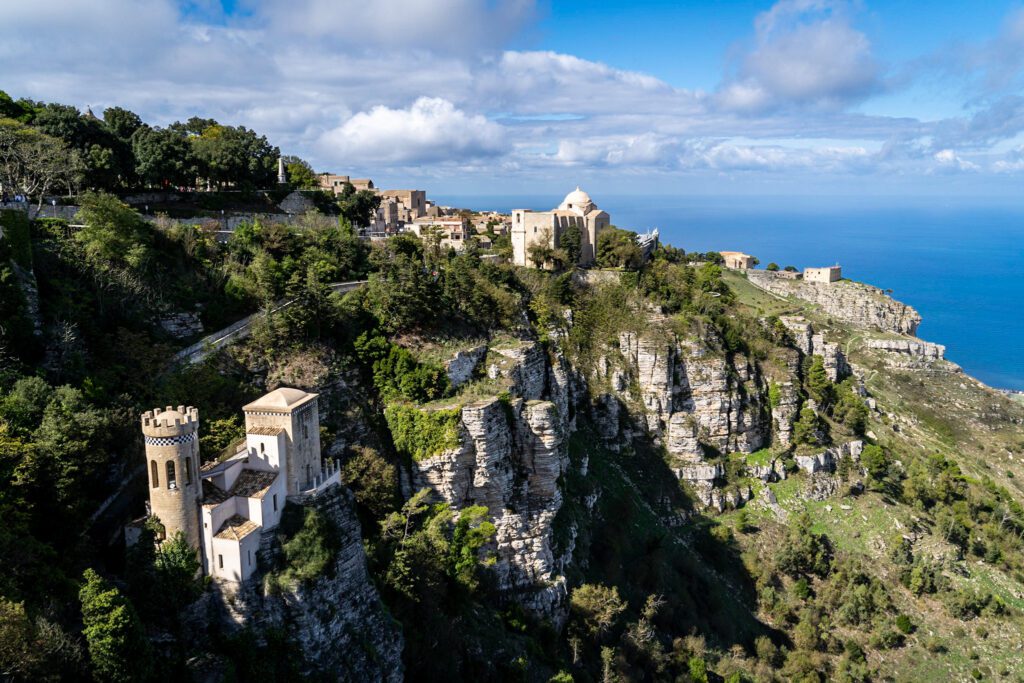
Add a Night in Trapani to Visit Erice & San Vito Lo Capo: We’ll be honest, we weren’t blown away by Trapani or Erice, which is why you won’t find it in the main itinerary above. Erice is beautiful, sure, with its hilltop town looking down over Trapani to the west and Castellammare del Golfo to the east. But it’s pretty touristy, and only worth a few hours of your time. We skipped San Vito Lo Capo, a beautiful beach town at the northwestern tip of Sicily, because the weather was terrible, and it didn’t seem like we’d be getting the best of the town in mid-October. A night in Trapani should give you enough time to do a day trip to Erice in the morning, and then spend the afternoon out in San Vito Lo Capo.
Day Trip to Cefalu from Palermo: Cefalu is an easy day trip from Palermo, but given 14 days, we’d opt to spend the two and a half days you have near Palermo in the city itself. With an extra day, take the train out to the beach, hike up to La Rocca for exquisite views, and get a spritz and aperitivo overlooking the beach.
Explore the Islands Off of Trapani: Spend a couple of days on Favignana, or one of the other islands in the Egadi chain just off the coast near Trapani. You can do it as a day trip, but it’s better as an overnight. Here’s a guide to Favignana that we enjoyed.
…Or the Aeolian Islands and Stromboli: At the top of our list for a return trip to Sicily? The Aeolian Islands and Stromboli off of the northeastern coast of the island. Stromboli, like Mount Etna, is an active volcano. Except instead of being on the island of Sicily, it’s in the middle of the ocean. The surrounding chain of islands are full of beautiful sandy beaches, and more solitude than you’ll find just about anywhere else in Italy. Here’s a travel guide to peruse for inspiration, if you go this route.
When to Visit Sicily
We have an interesting point-of-view on this, since we were in Sicily for three weeks starting at the beginning of October.
Every single travel guide, blog, and post we’ve read about Sicily says something along the lines of “summer is great but it’s too hot and too crowded, so come in shoulder season like September or October instead!” Which is true. Kind of. But that description is missing an important piece of information that we think you should know before deciding when to visit Sicily.
In October, something happens that is almost certainly going to have an impact on your trip. Small business owners go on vacation. Sometimes it’s for a week, sometimes two, sometimes a whole month. About 30-40 percent of places we tried to go – bars and restaurants, mostly – were on holiday during the first two weeks of October. Some close completely until the following spring!
Locals we met along the way warned us about this phenomenon, and there were several times during our visit that someone said “we love X restaurant, but it’s closed right now.”
It is worth noting that this phenomenon largely affected the smaller towns in Sicily, rather than cities like Catania and Palermo.
All the main sights are going to be open (in our experience, anyway), but if you have specific places to eat and drink picked out, there’s a chance they’ll be closed if you come in October. Not necessarily something to stop you from visiting in October, but something to keep in mind as you decide.
In fact, we’d recommend October, which is when we were in Sicily. Sure, the weather includes a little more rain and thunderstorms (not as many as your weather app will make you think, however, don’t trust any weather app – I’m convinced they’re all out to set expectations low so that you’re stoked when it’s 75 and sunny out), but it’s also relatively quiet and calm, and we basically had most of the places we went to ourselves, or shared them with a small group. Plus, parking was a breeze everywhere we went – we only paid for parking in a city ONCE.
September is better if you want to eat out, experience the nightlife, and things like that. It’s a nice blend between the weather in summer (but slightly more bearable), and the lighter crowds.
Summer – June through August – is blazing hot, which makes it far less pleasant to be trekking around the Valley of the Temples, or hiking in the Zingaro Nature Preserve. Crowds are higher too, which means a corresponding increase in prices.
Still, there’s a reason Sicily in the summer is so popular – it’s beautiful, the weather is perfect (okay, it’s a little hot), and there’s a palpable energy that comes with thousands of people descending on the island. It does mean that you’ll be waiting in more lines, circling for parking spaces more often, and paying more for your accommodations and rental car.
Late fall, winter, and early spring are going to be very, very quiet. Things are closed, the weather isn’t great (though still better than northern Italy, for sure), and it’s generally not the best time to visit if you want to have a Sicily experience full of sunshine, amazing views, and stunning sandy beaches.
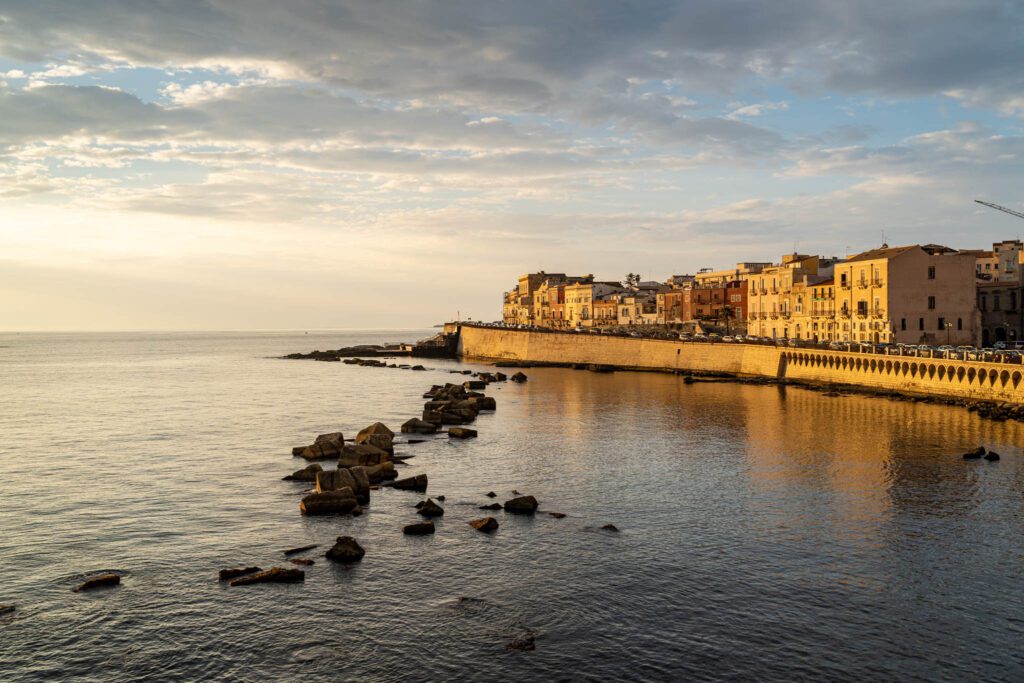

AMAZING ARTICLE!
Thanks a lot for making such a detailed trip for us. Im going there in a Month, following many of these tips you gave.
Thanks !! 🙂
No problem, Bastian! Hope you had an amazing trip. We LOVED Sicily!
Great post, thank you! We are also going in October, but sadly only have 8 days/nights. We were planning on flying into Catania and out of Palermo but instead will follow your advice and stick to just one side. At that time, 3rd week in October, would you recommend the South/East around Catania or the North/West around Palermo? We were most looking forward to Taormina and hiking the Zigaro reserve, so will have to decide between the 2. Knowing the weather will likely not be ideal and we wont be swimming, and perhaps spending more time away from the coast, I wonder if one of the cities is “better” than the other? Did you prefer one city over the other? Thanks!
Hey Lauren! Sadly, I think your trip might have already happened, but I’m going to answer this anyway in case others have the same question.
With limited time, we’d opt for the southeast corner of the island, where you have Catania, Etna, Taormina, and Siracusa all within a relatively short distance. Plus, they’re all connected by a regional train line, so you don’t necessarily need a car.
That being said, we also really like Palermo, so if you’ve only got 3-5 days, you could make a strong case to spend it all on Palermo with a day trip to Cefalù (or something else nearby).
Many thanks, Matt! Your ‘Perfect Sicily Road Trip’ article is most informative. We are retired and planning an eight-week trip to Italy next October – November, with one month in Sicily. Although you identify shortcomings for late fall in Sicily, the trade off may be less tourists. Thank you for sharing your experiences and your recommendations.
Definitely, it’s all about tradeoffs! There will definitely be things closed, but there will be far less people. We were there in October and, while it wasn’t beach weather, it was amazing.
Hi there! I’m planning my honeymoon for ~12 days in Sicily in July. We want our trip to be romantic and less fast-paced than a typical sight-seeing vacation – we don’t want to have too many travel days moving locations! Do you have a recommendation of which side of Sicily or which towns we should prioritize for a romantic low-stress honeymoon? Thank you!
We’d definitely do the southeastern corner of Sicily in that case! There’s a TON to do and see within a few hours in a car/on a train, so you can get a nice balance of relaxing and exploring. With a slower pace, you could do something like Catania, Taormina, and Siracusa over those 12 days, with day trips to Etna and Noto. Sounds like an amazing honeymoon!